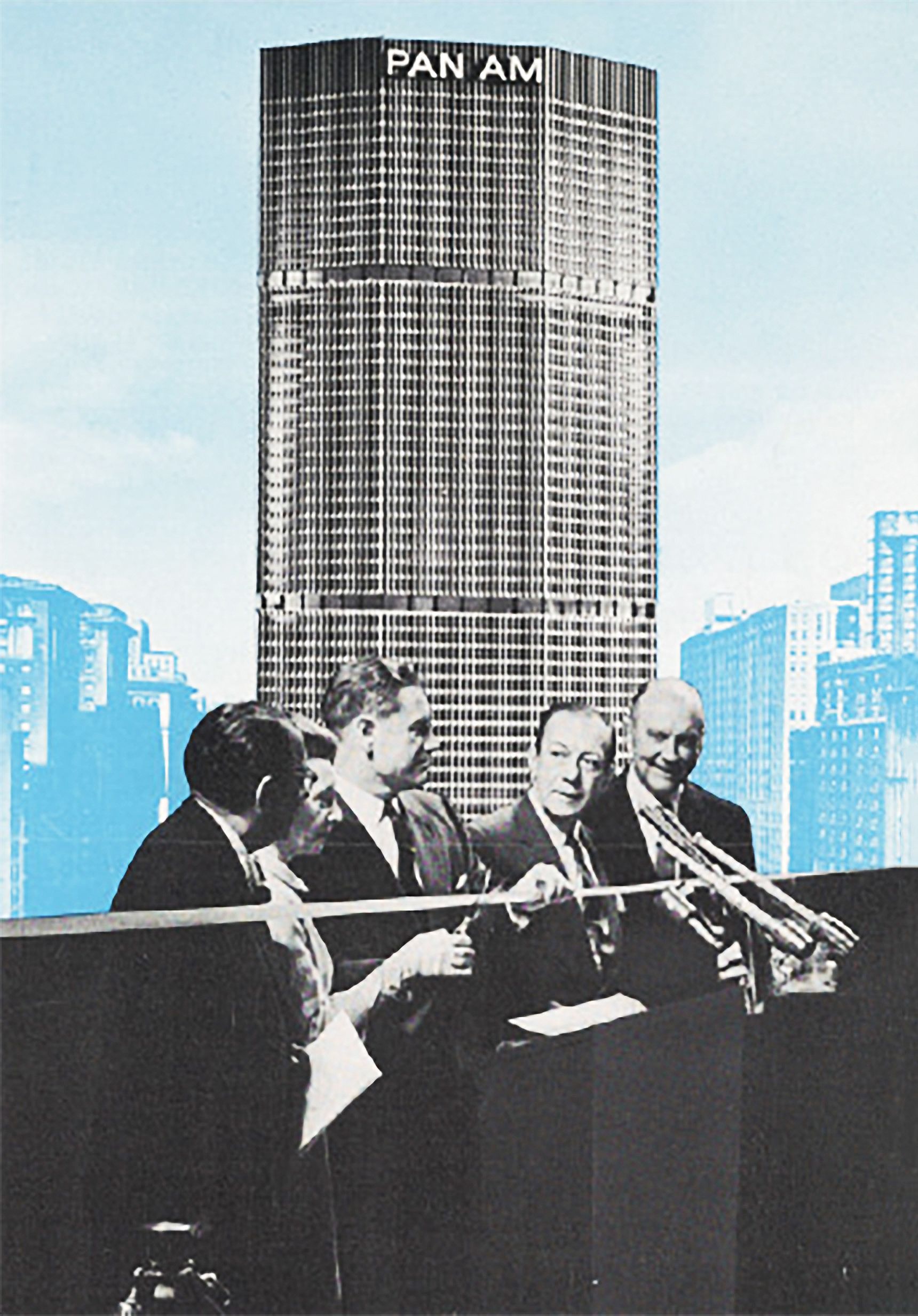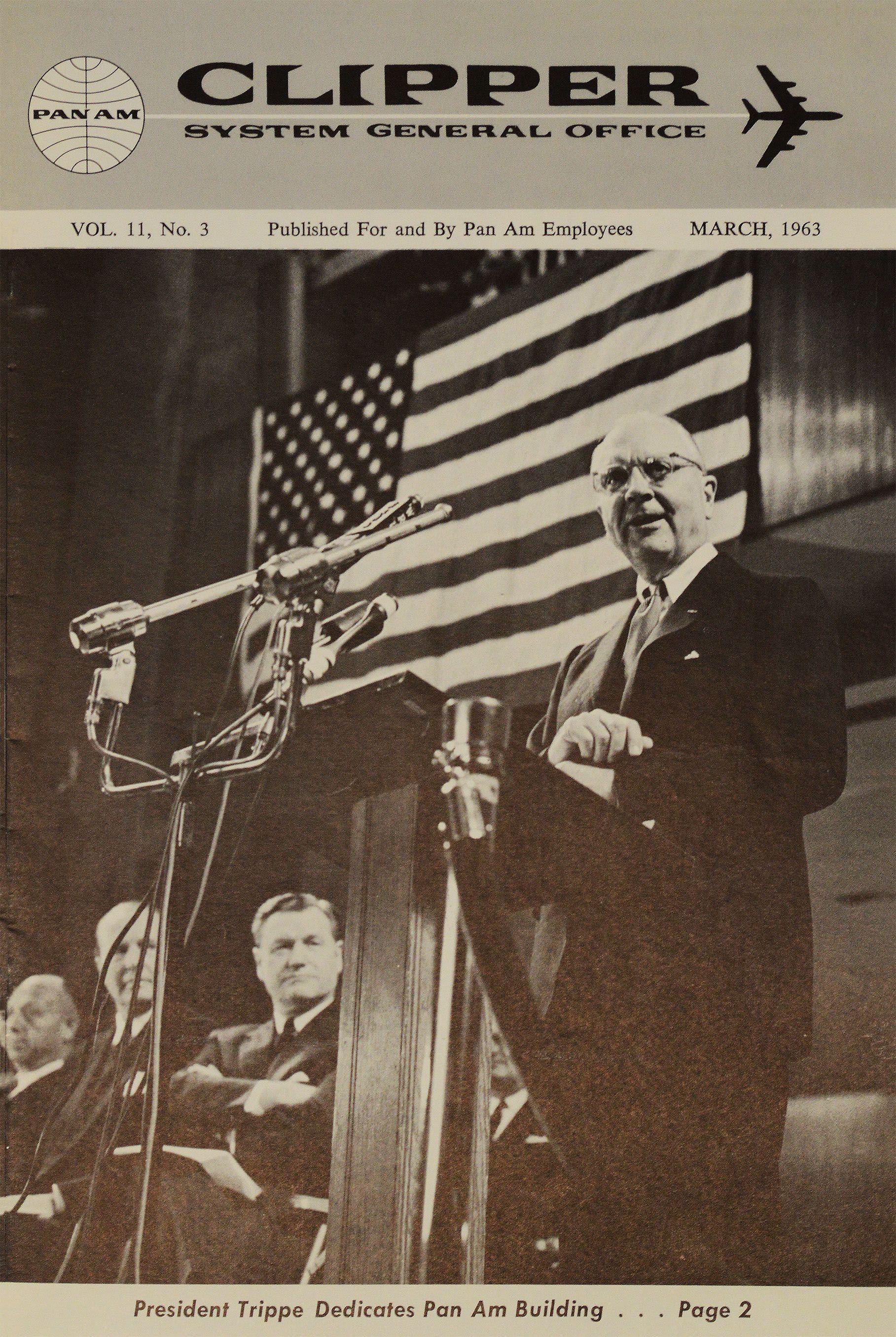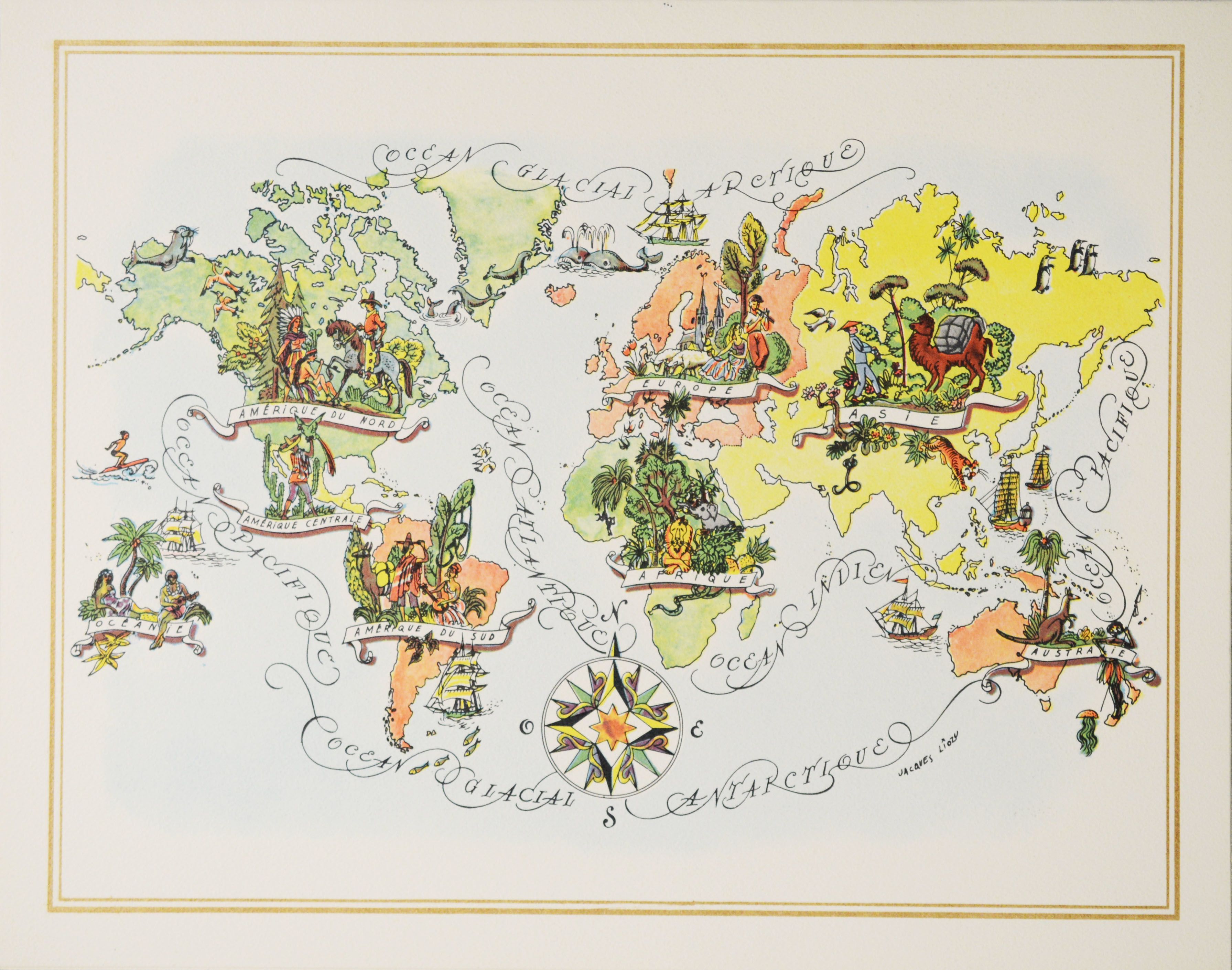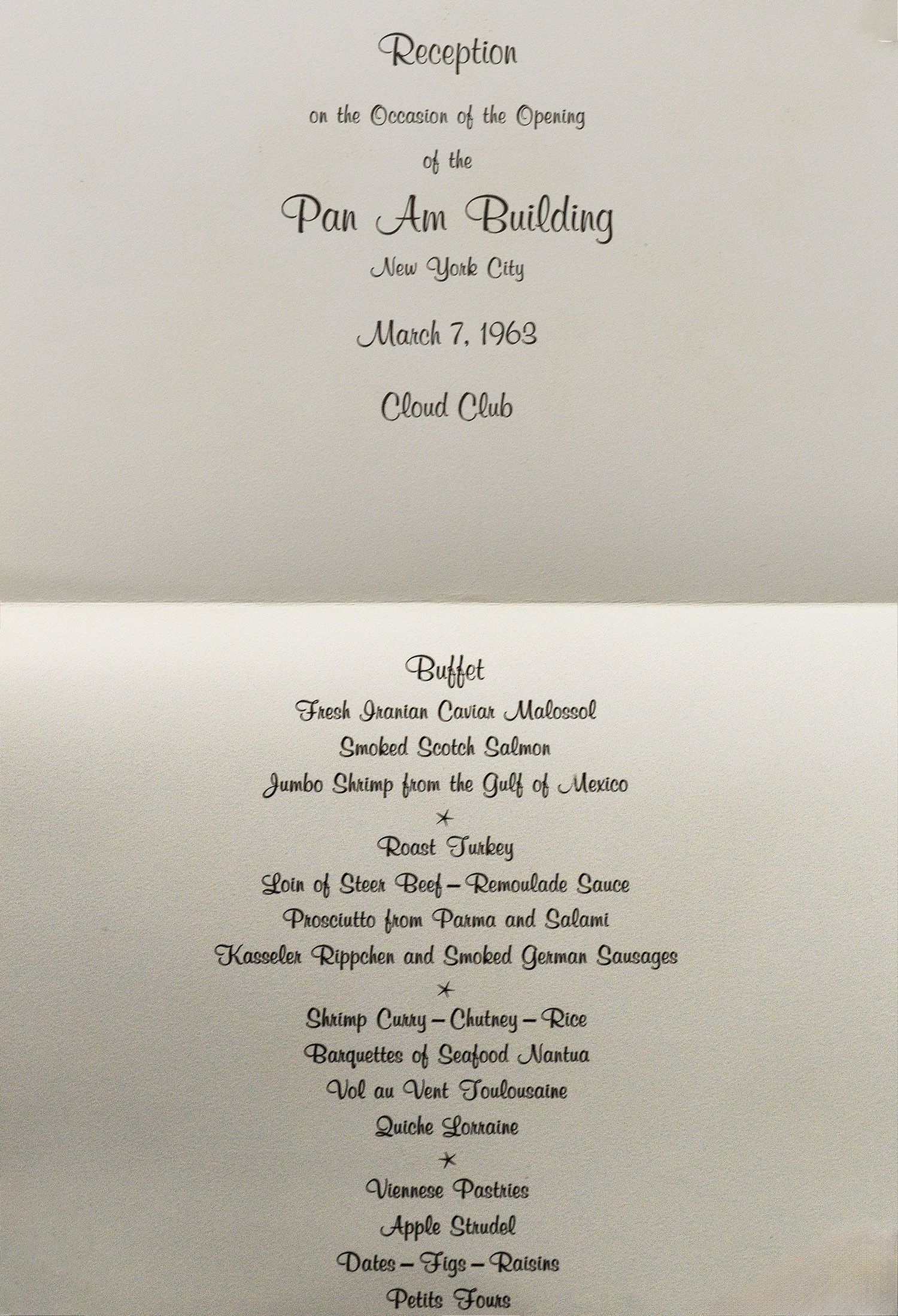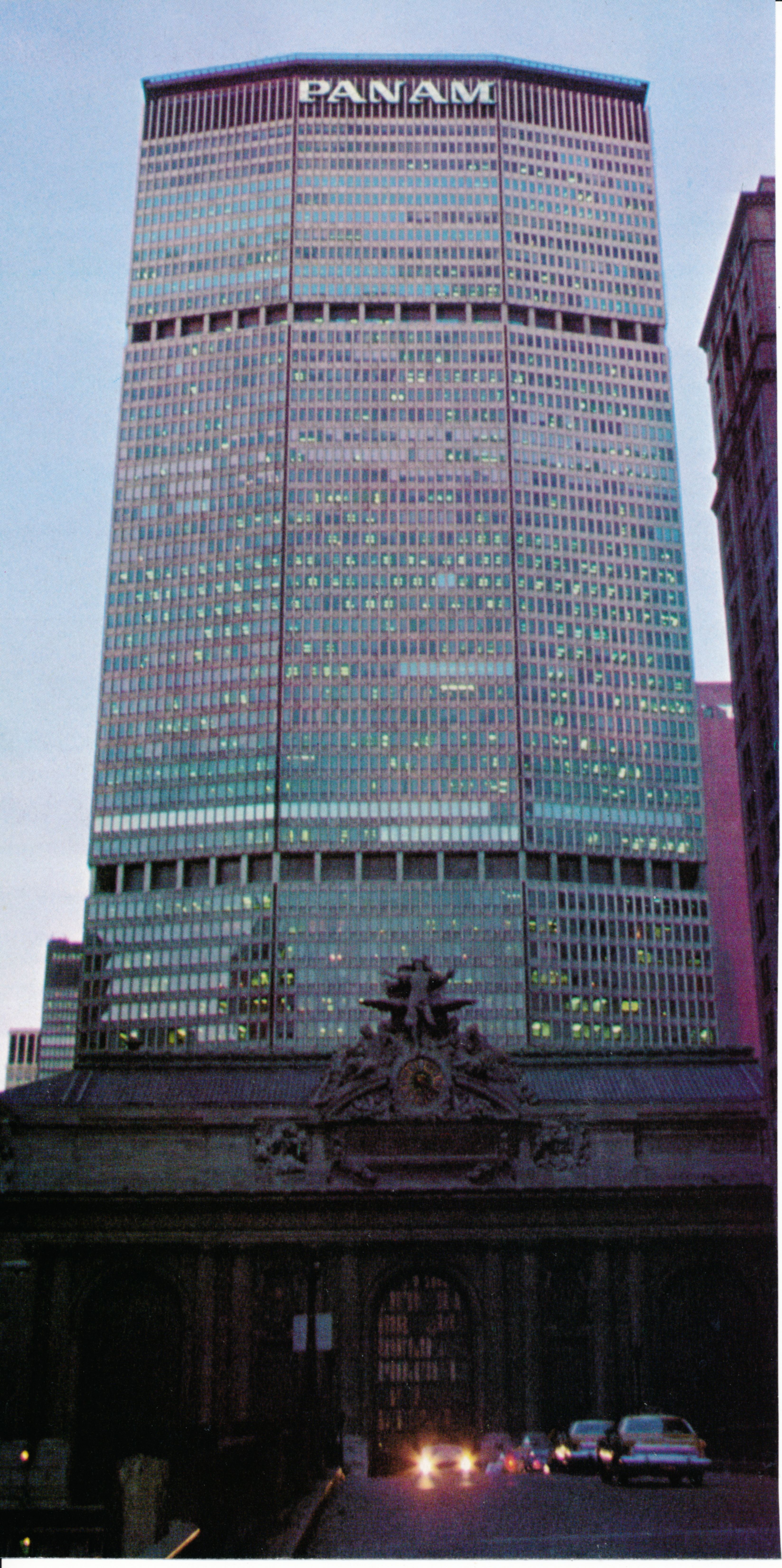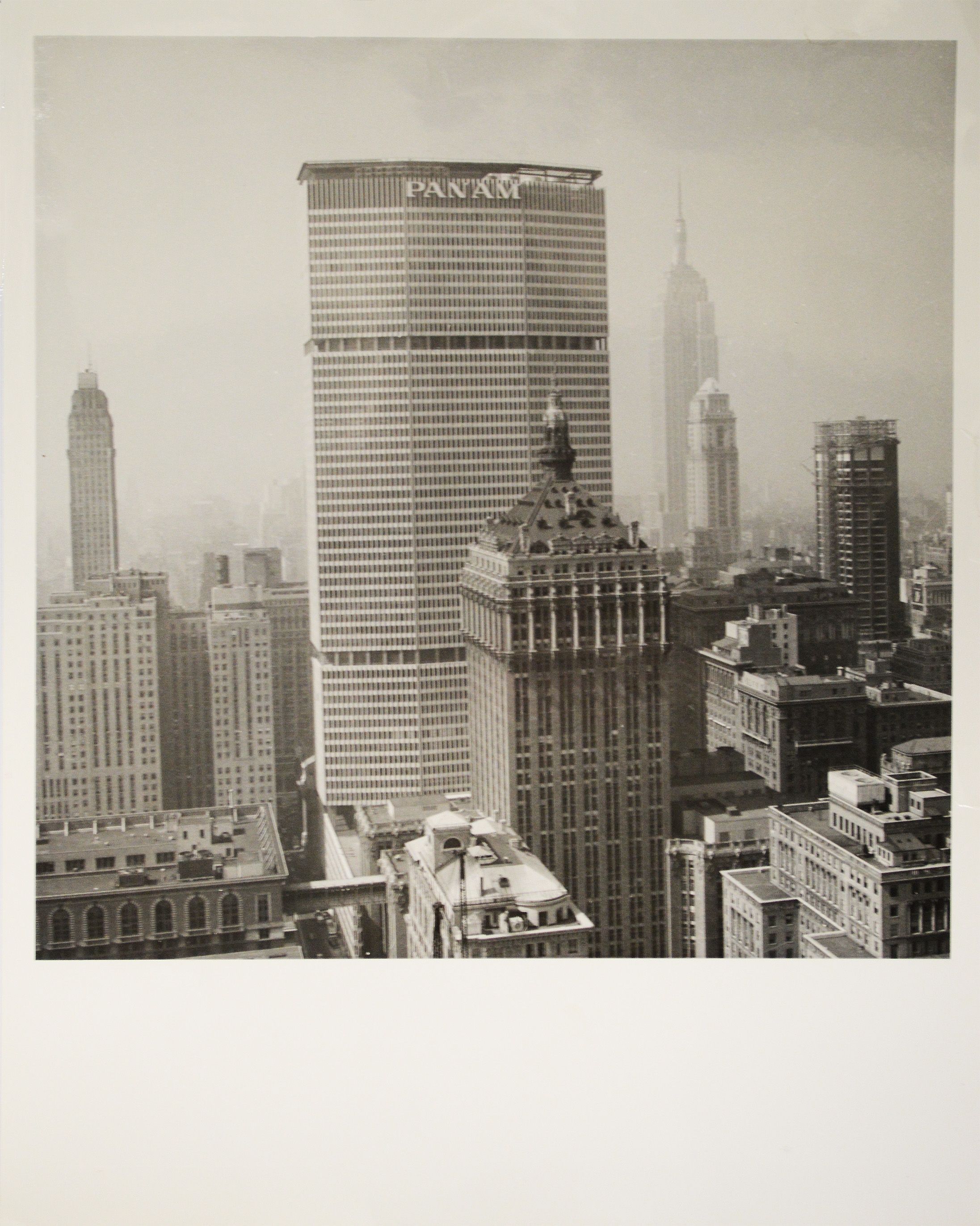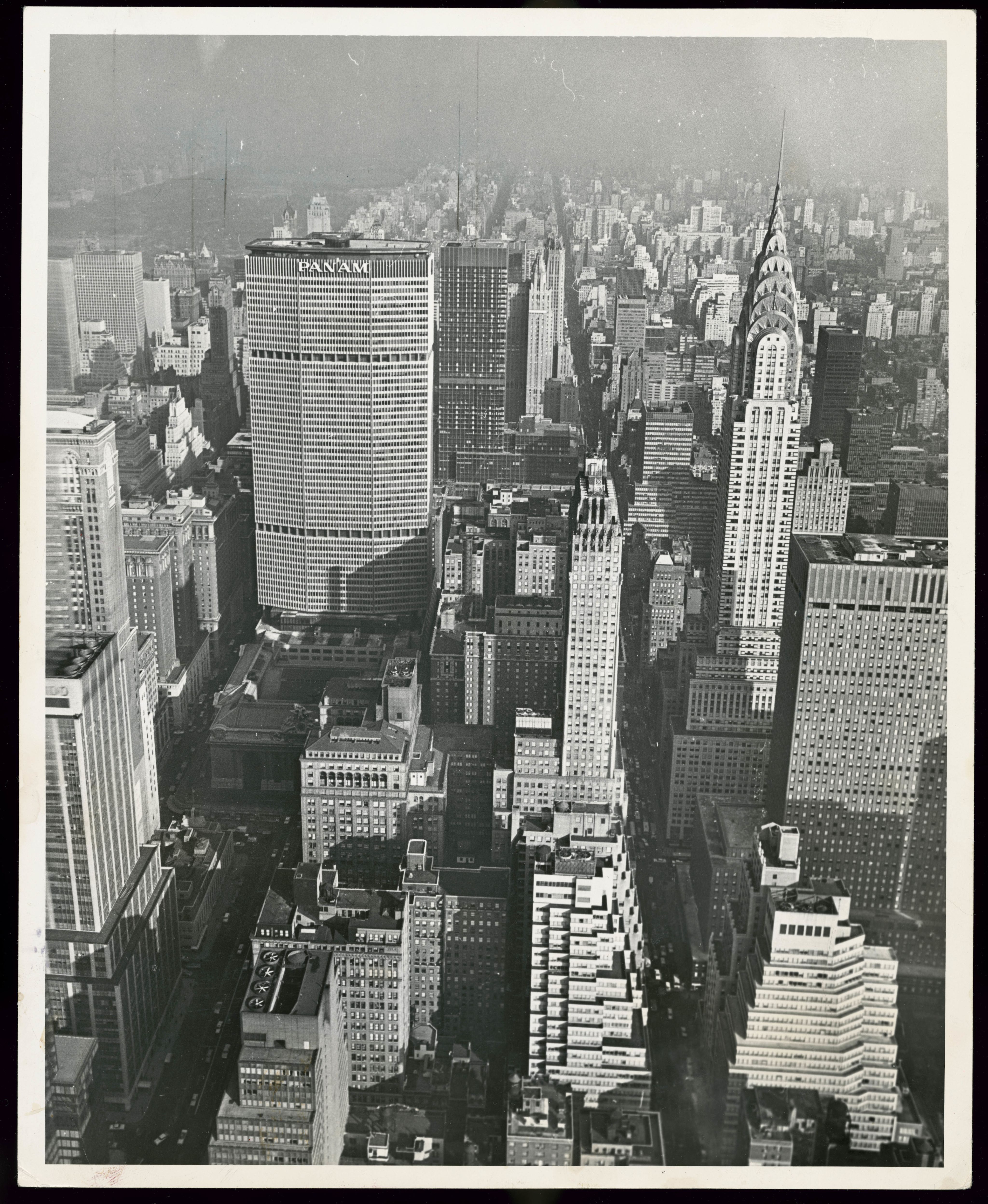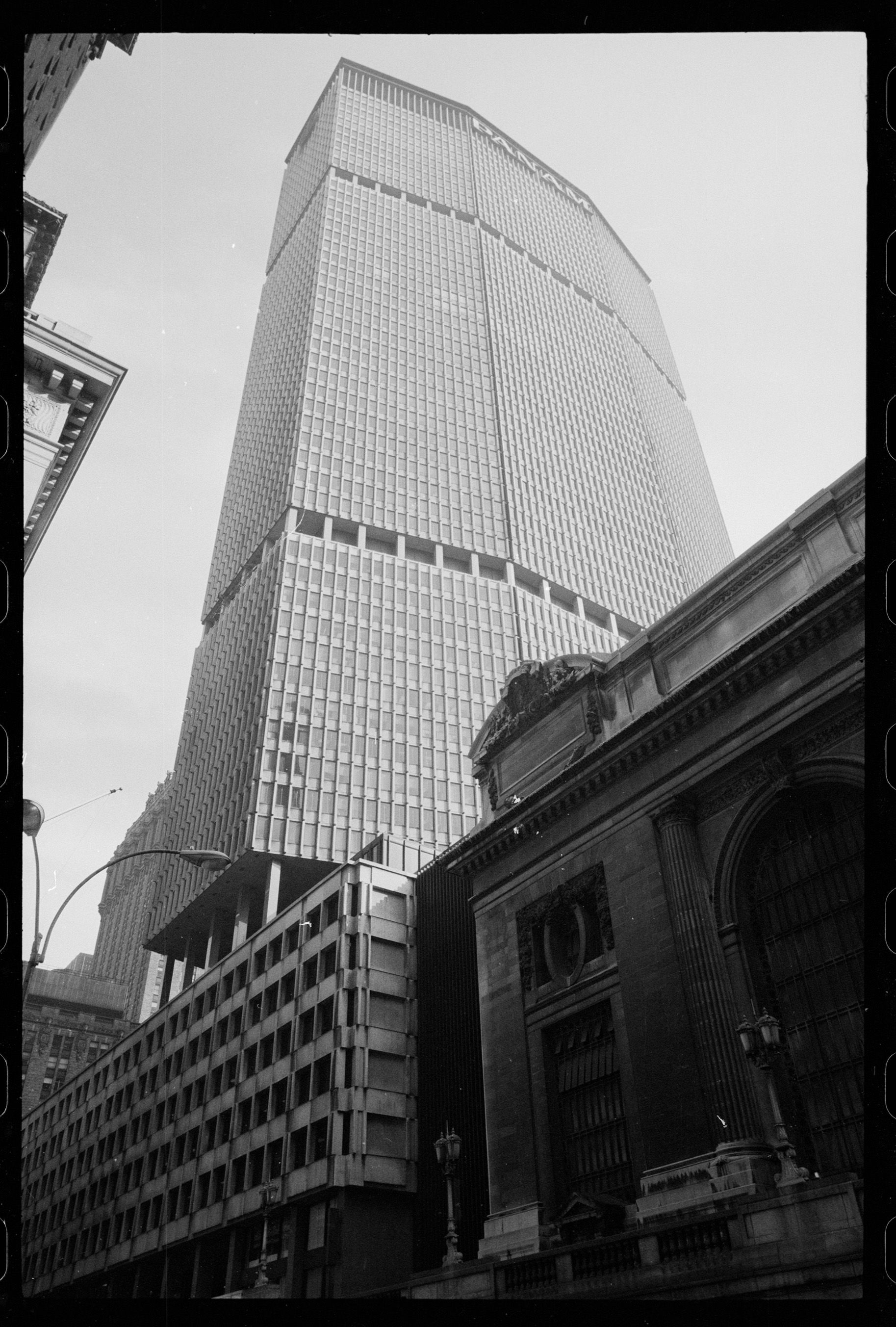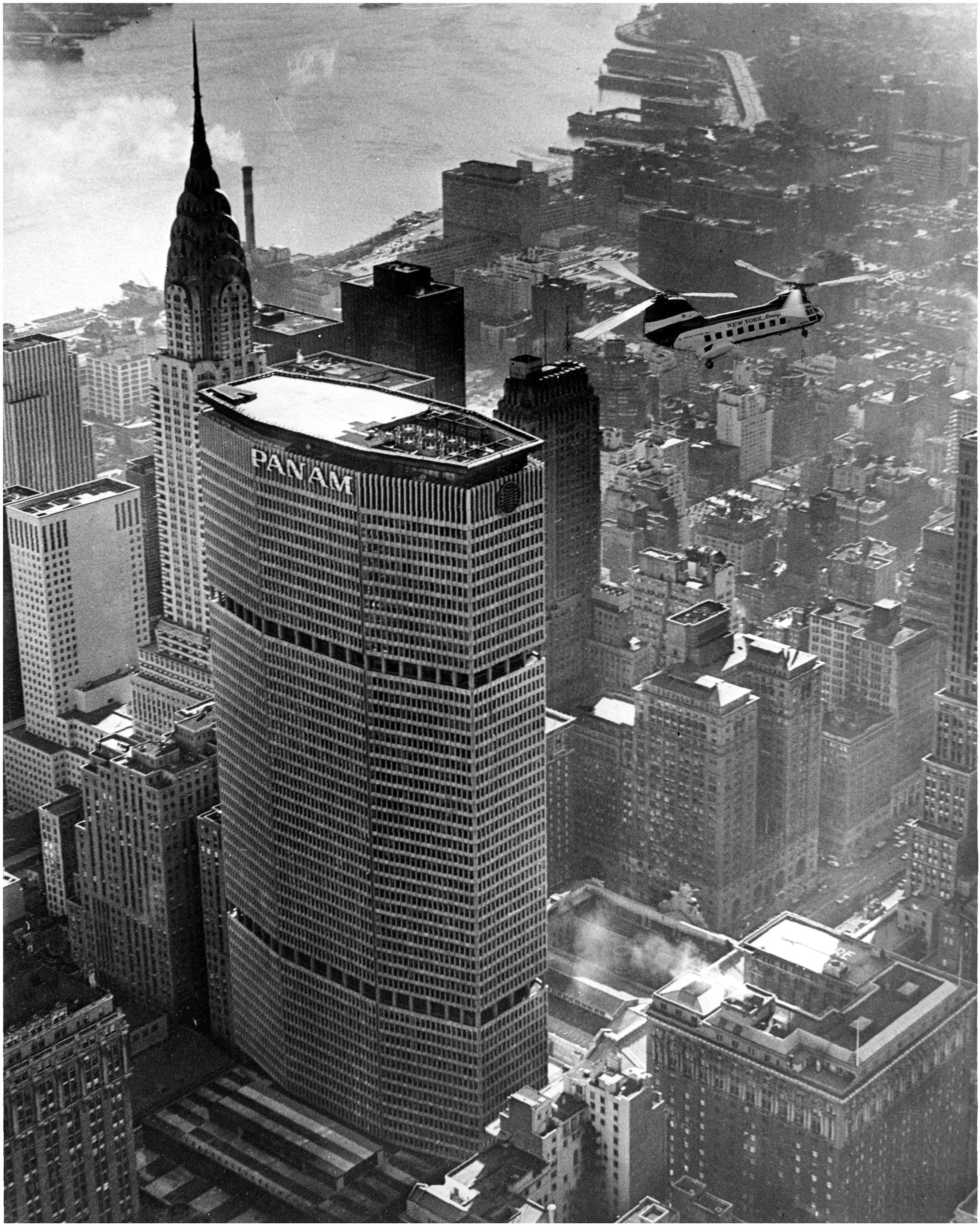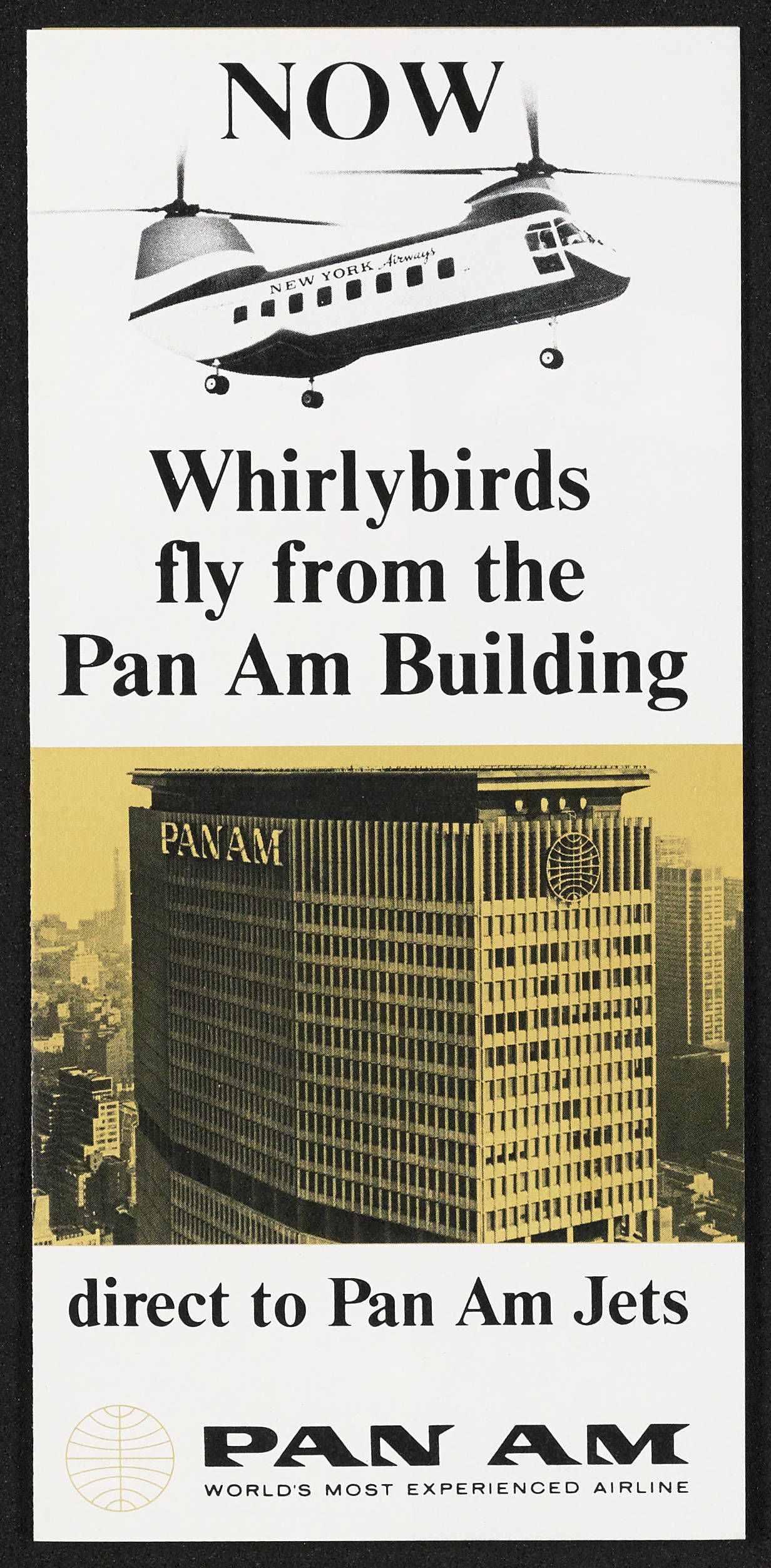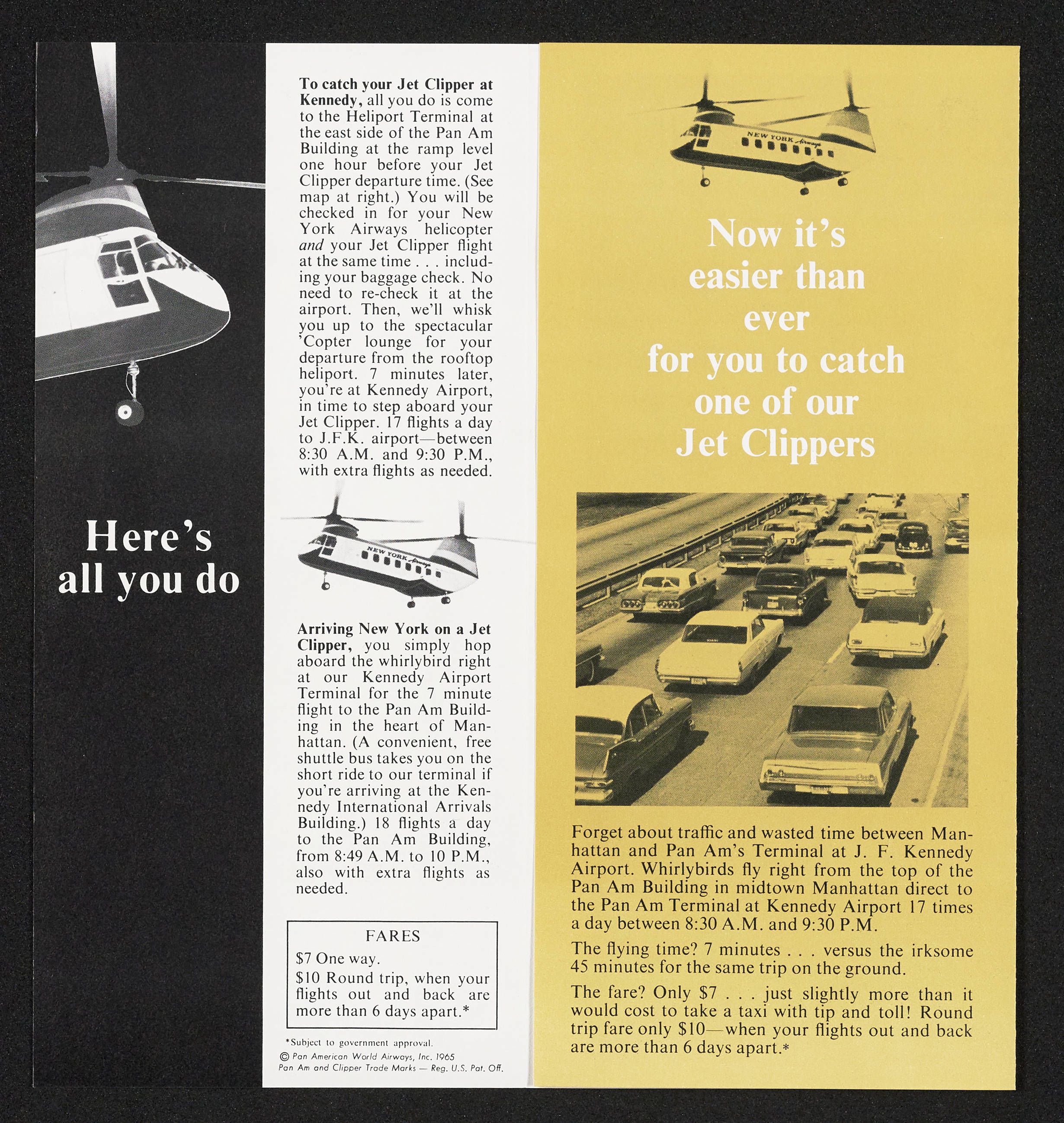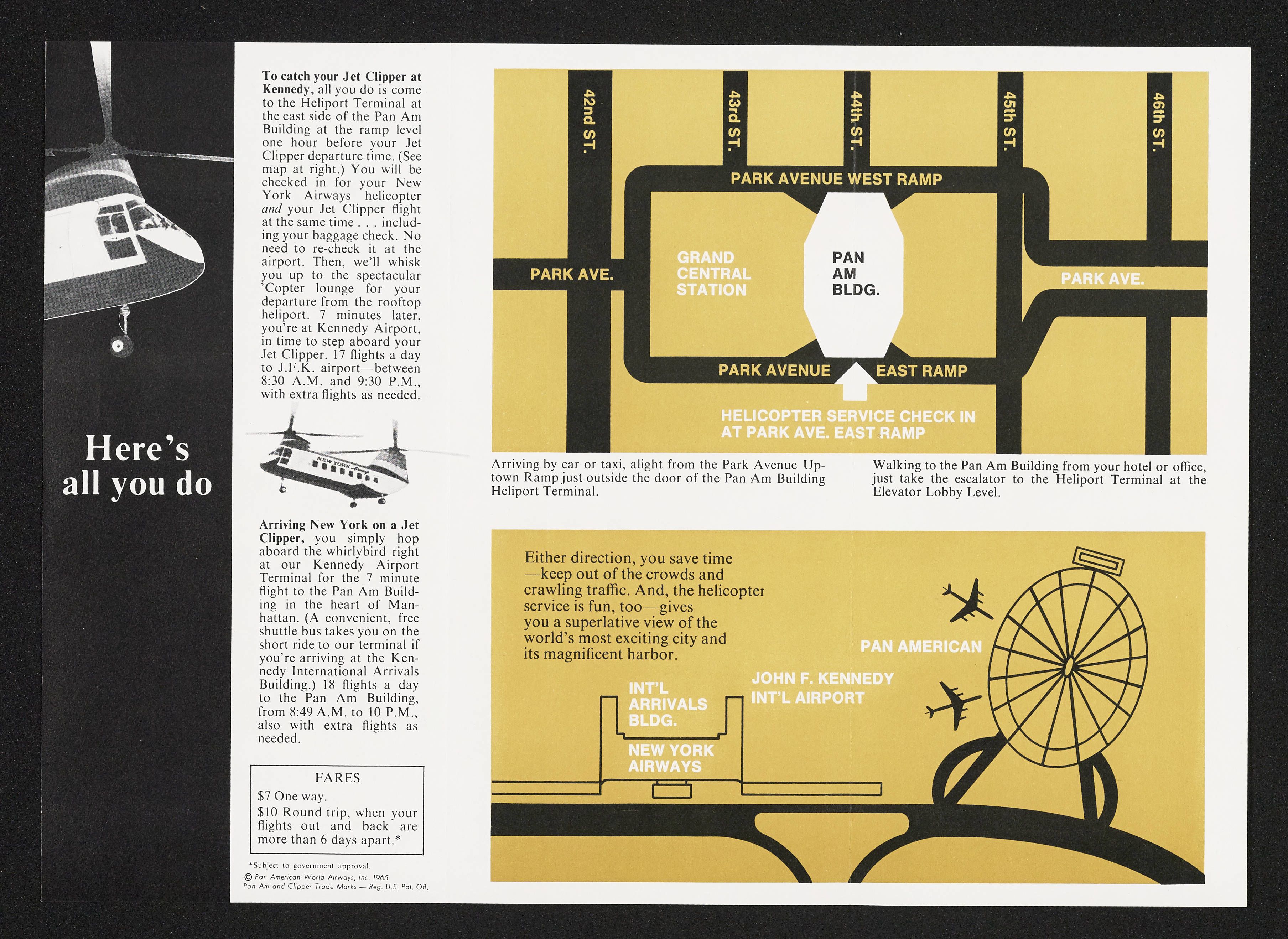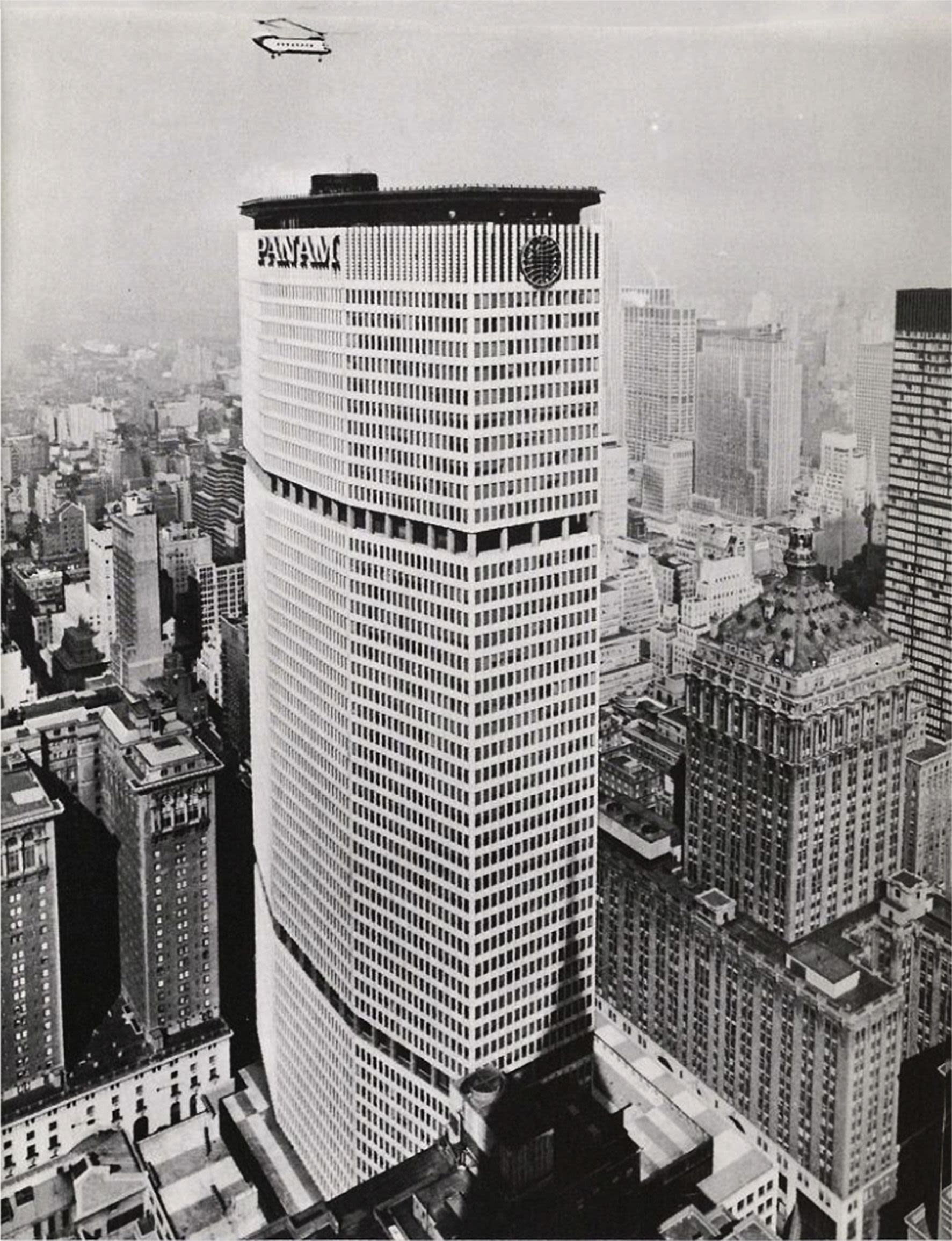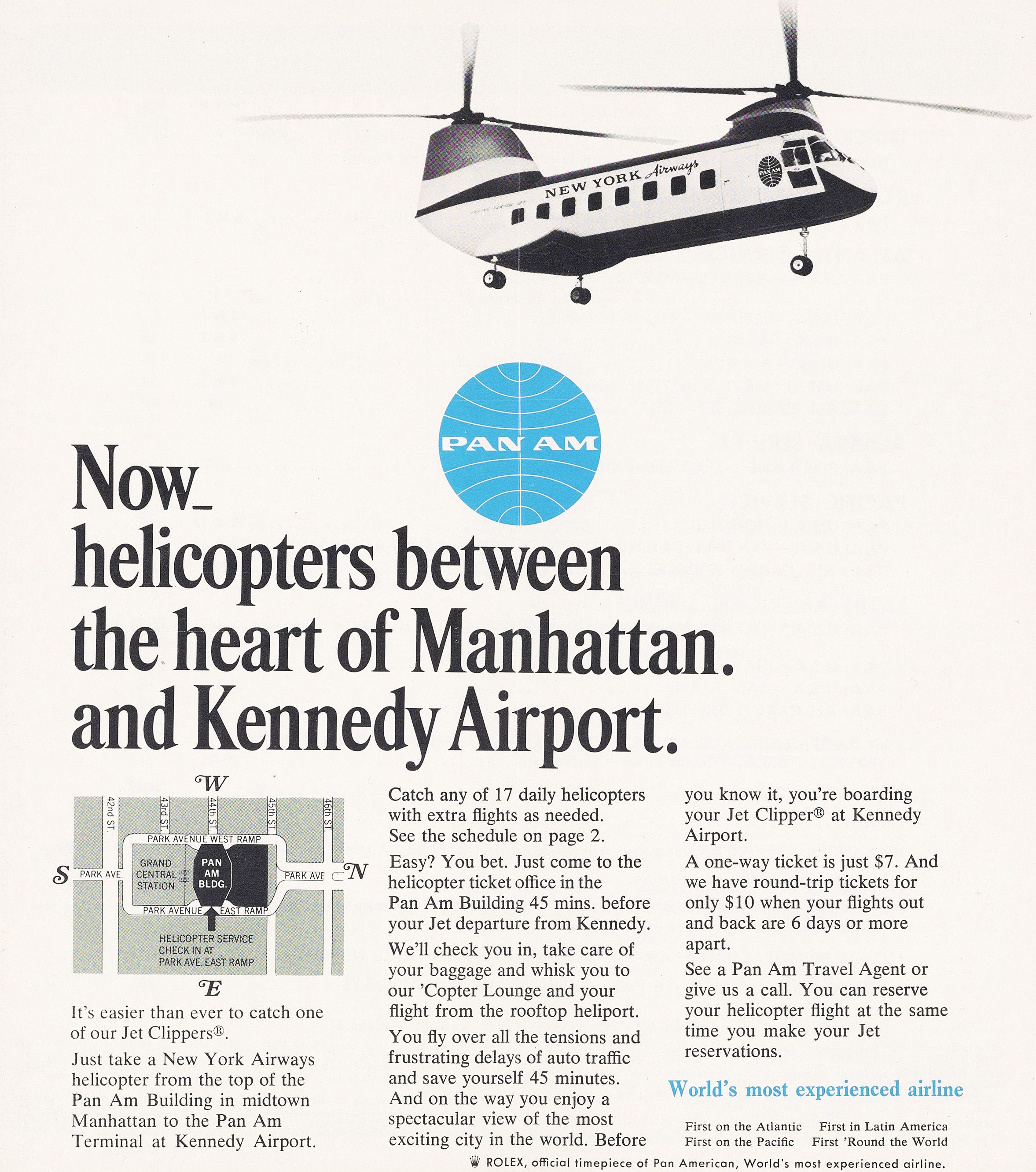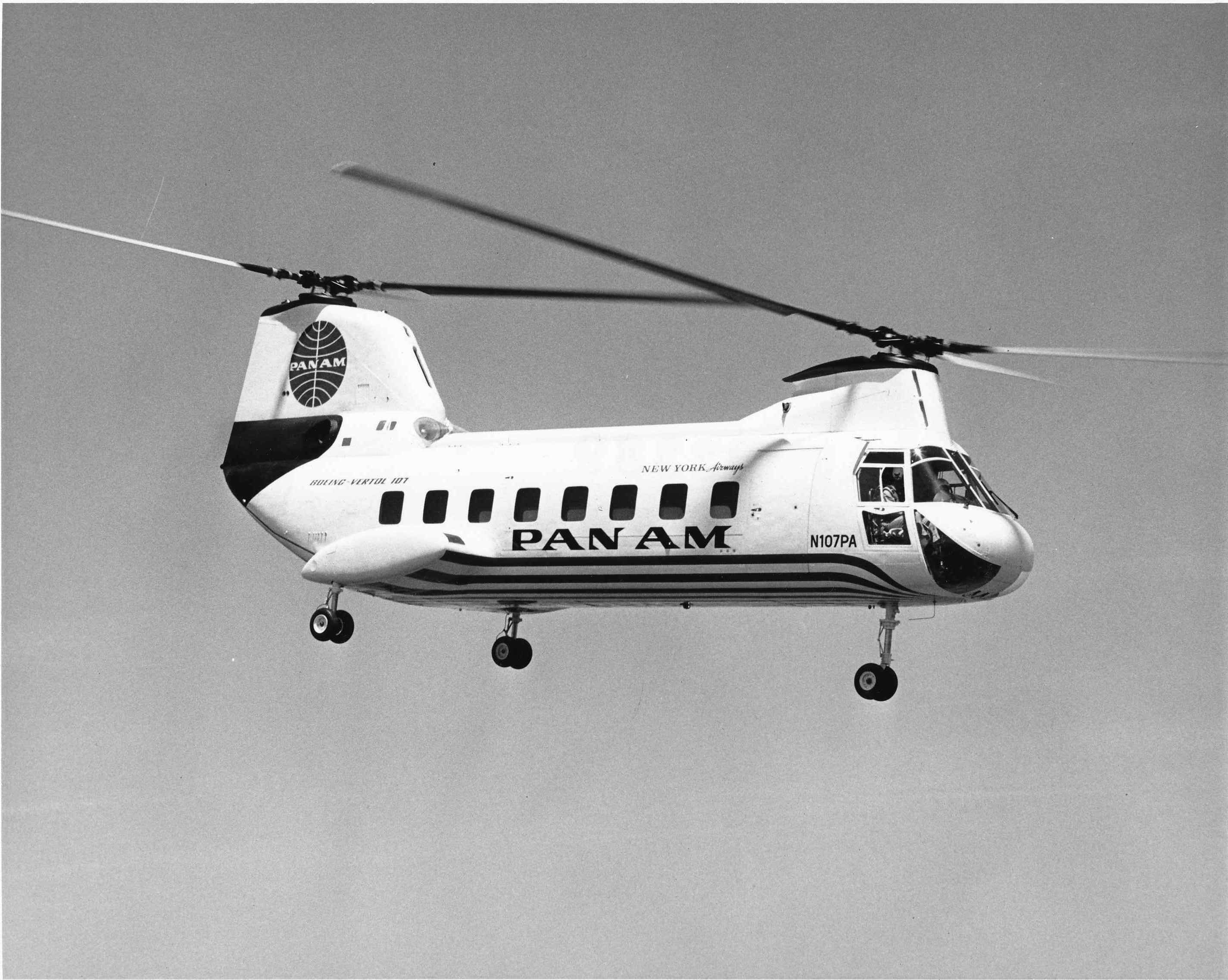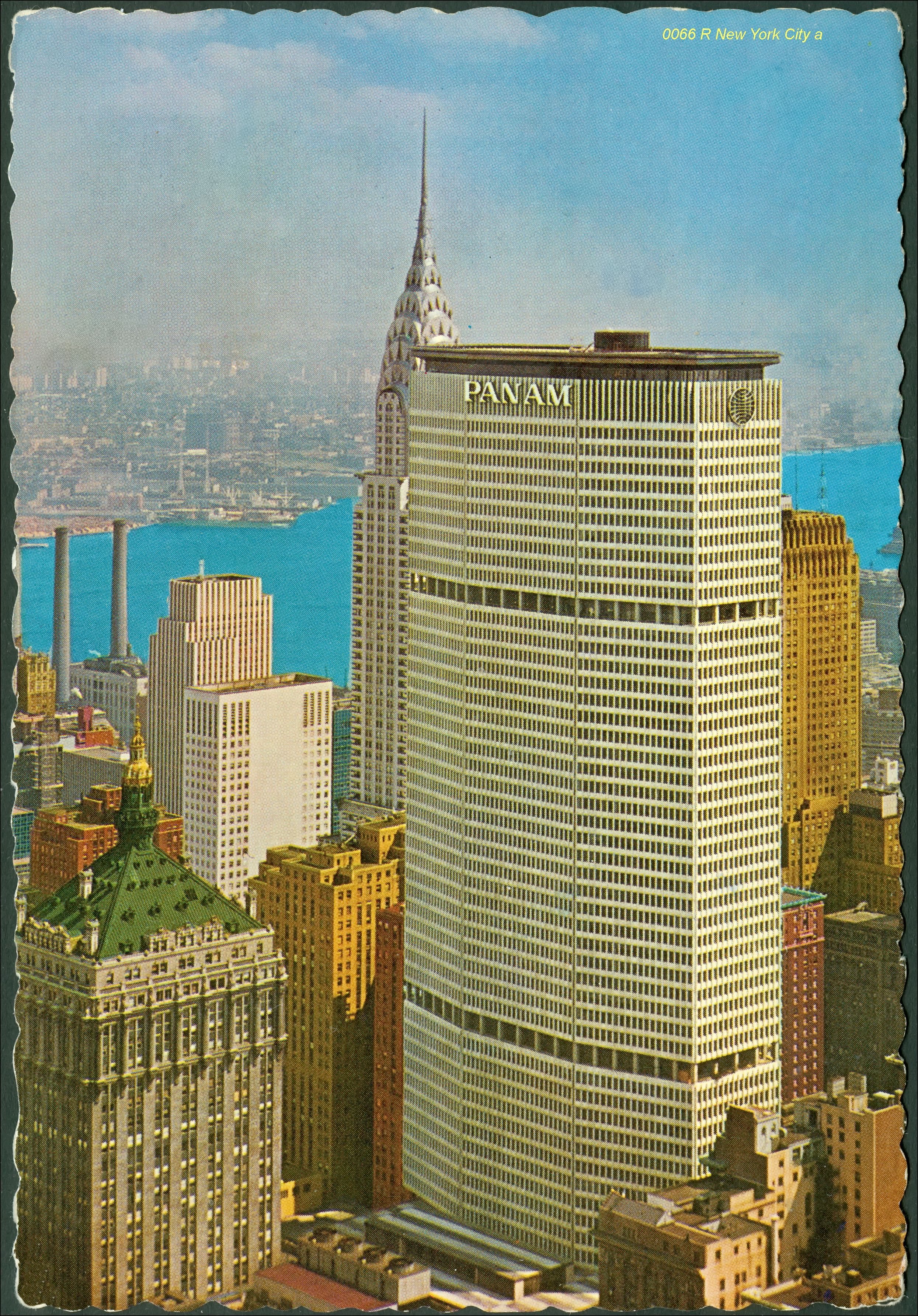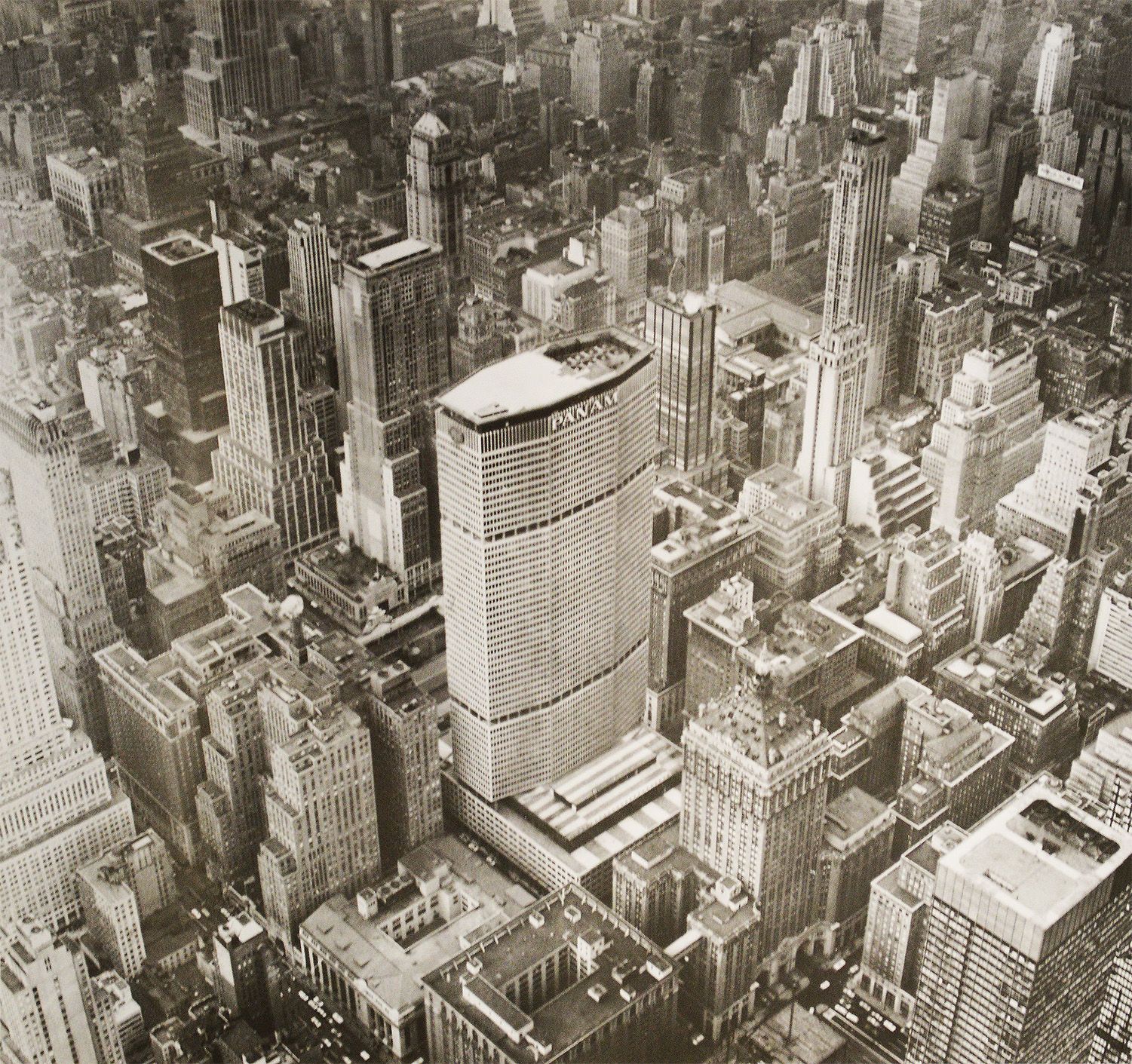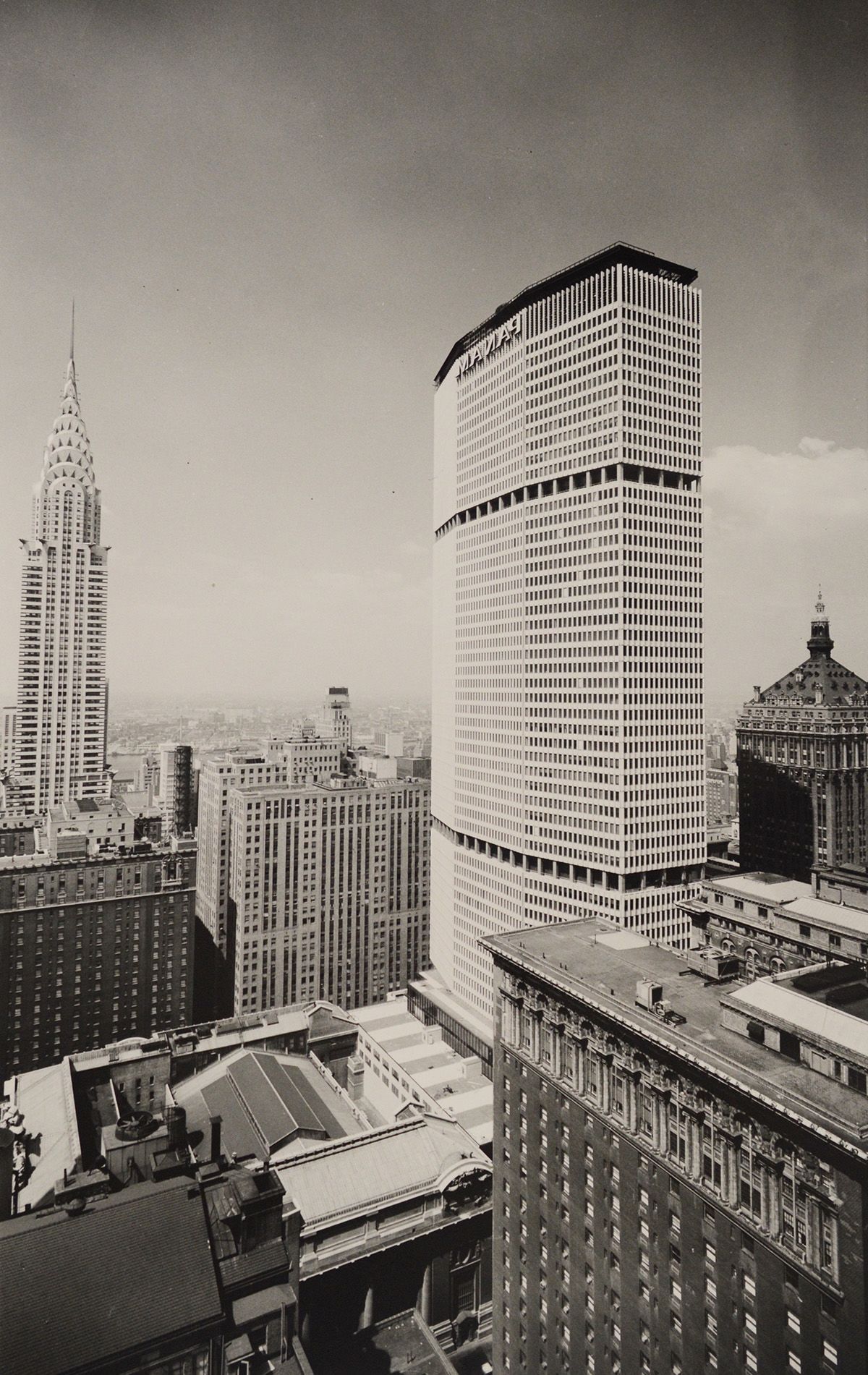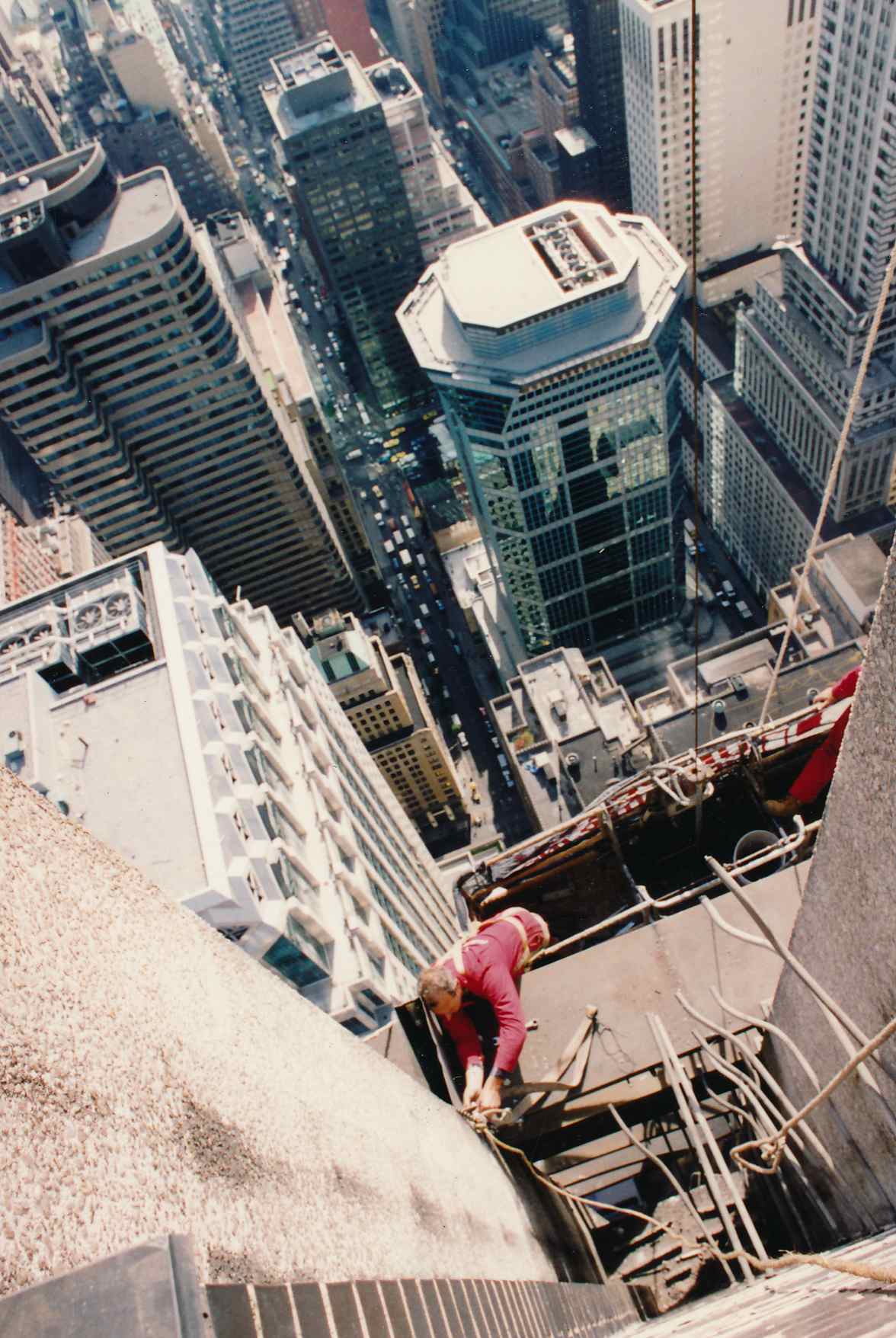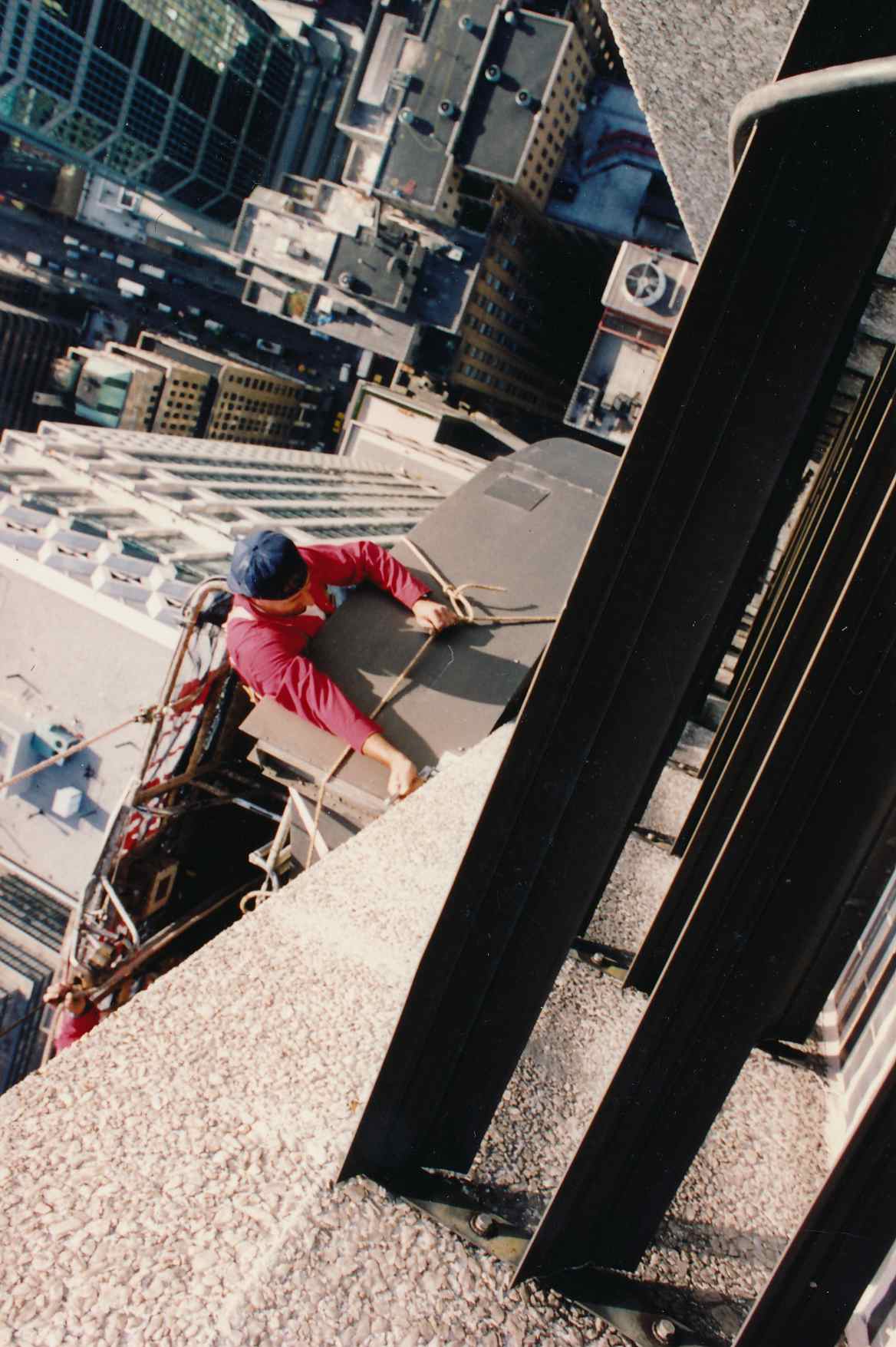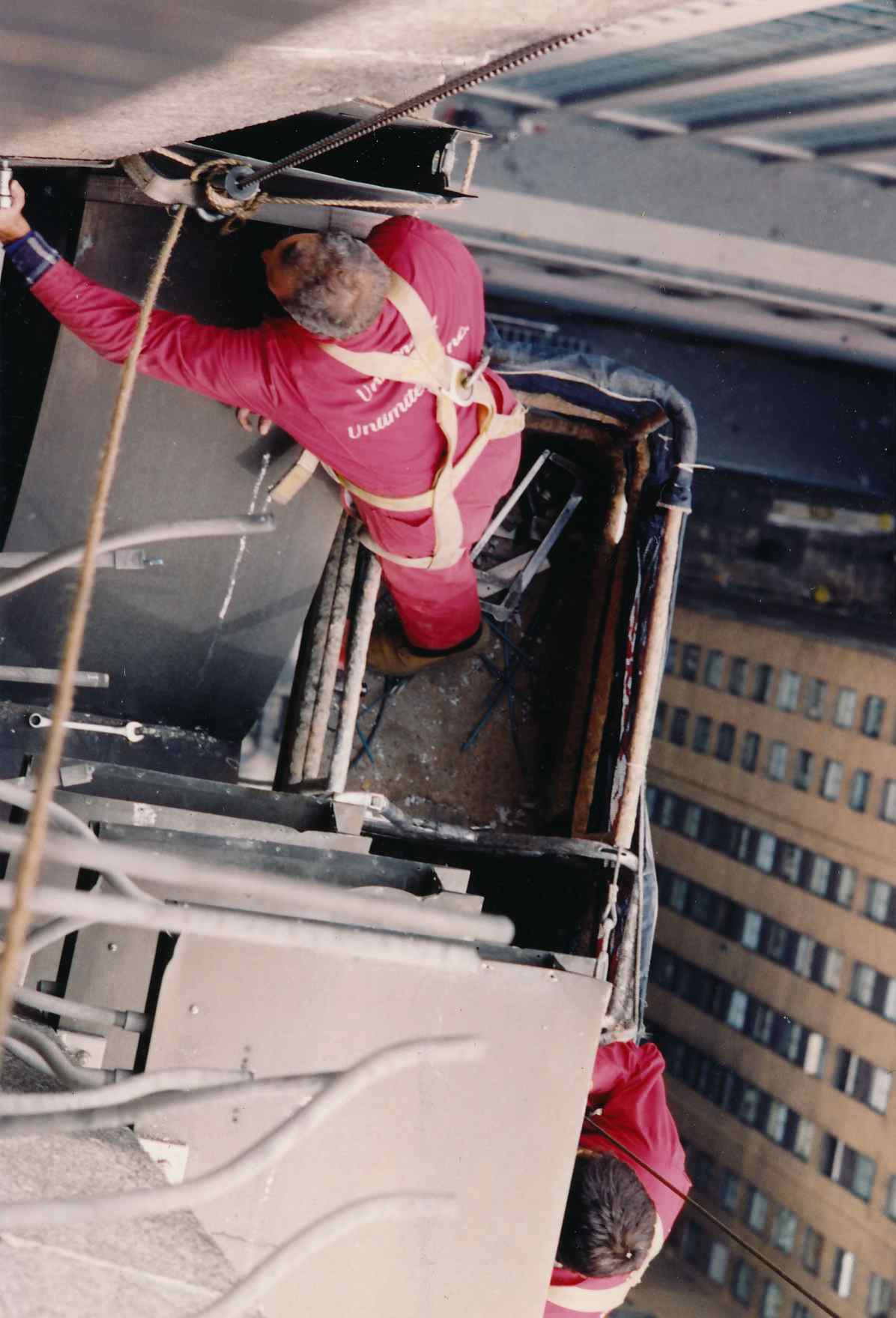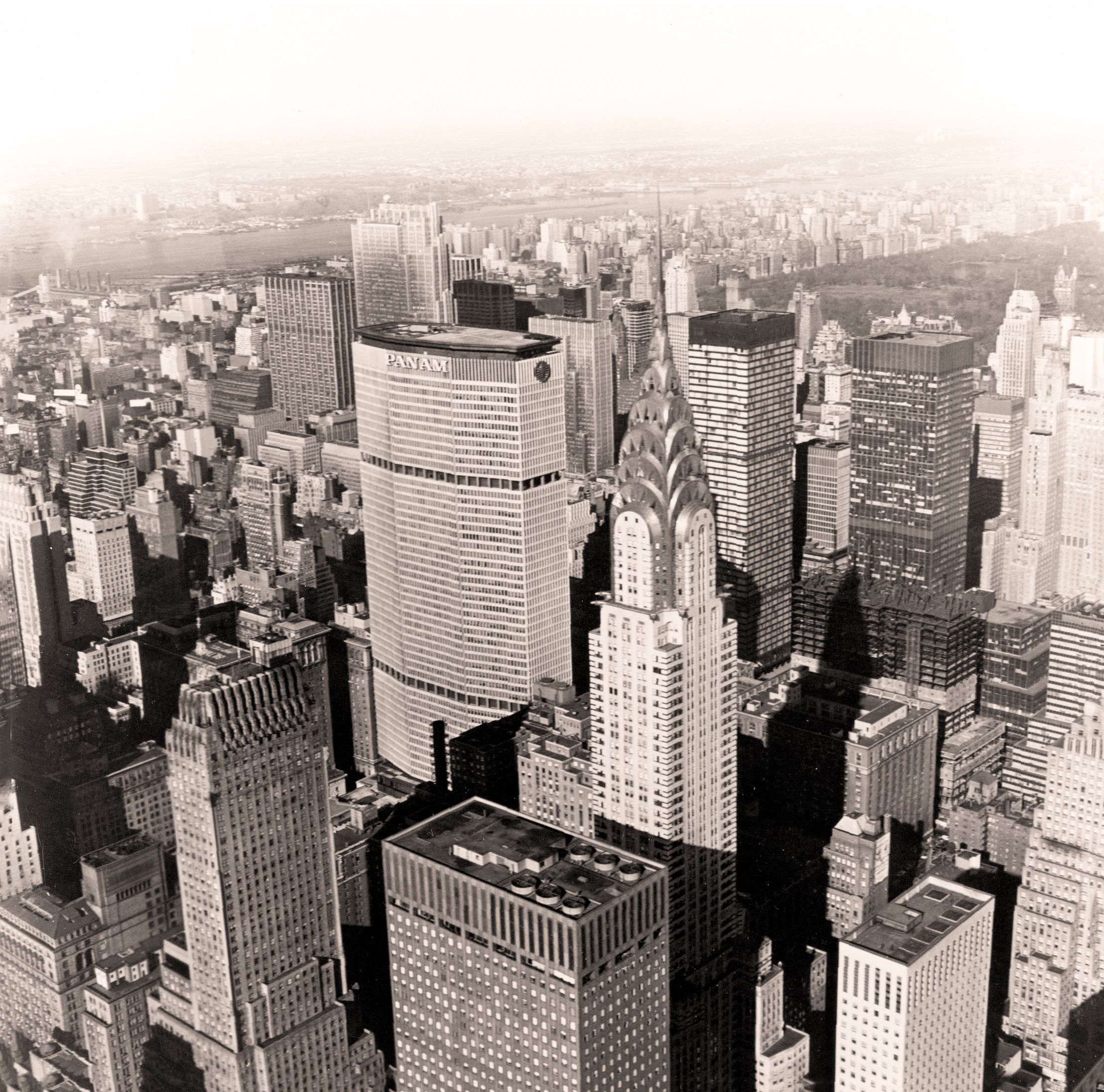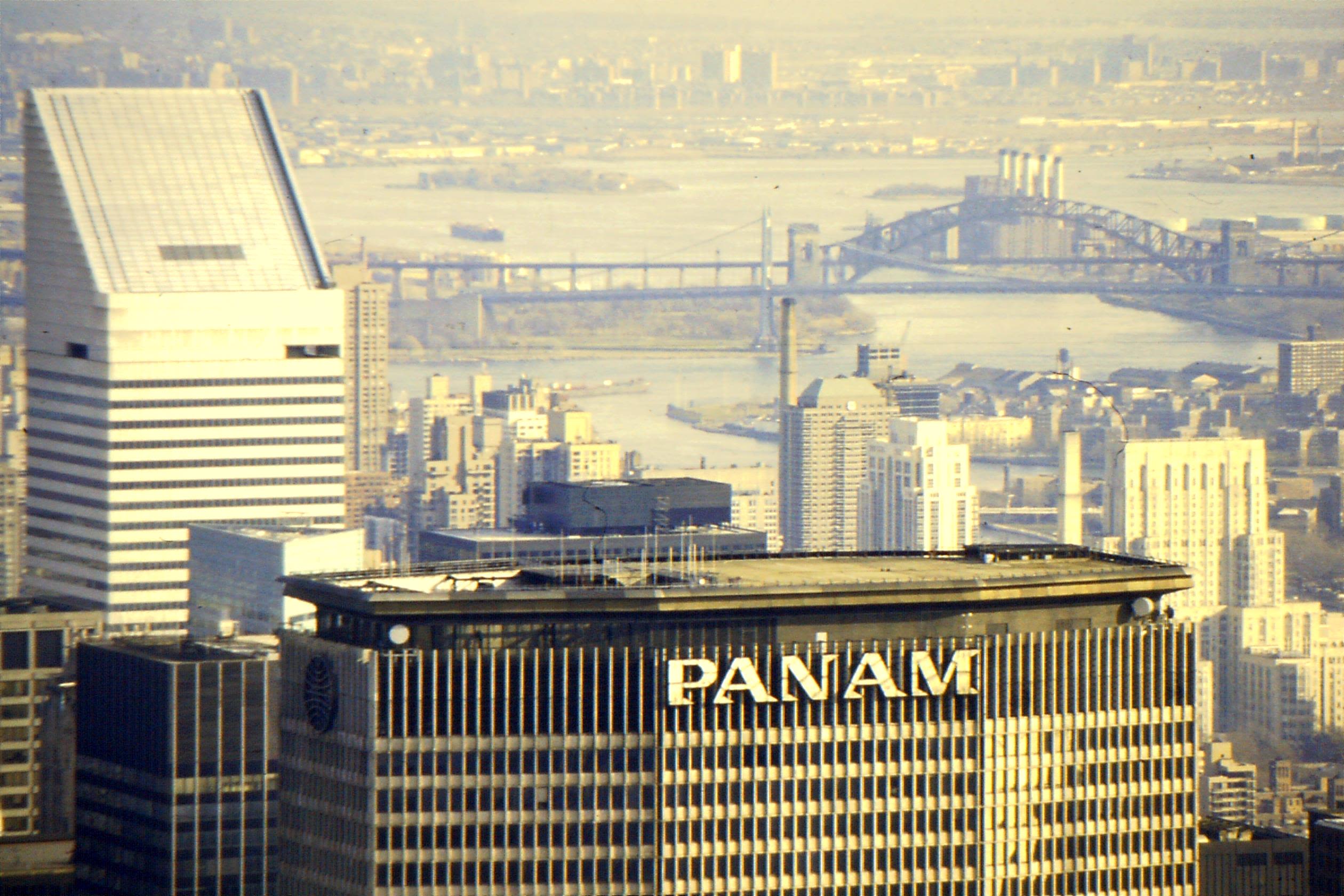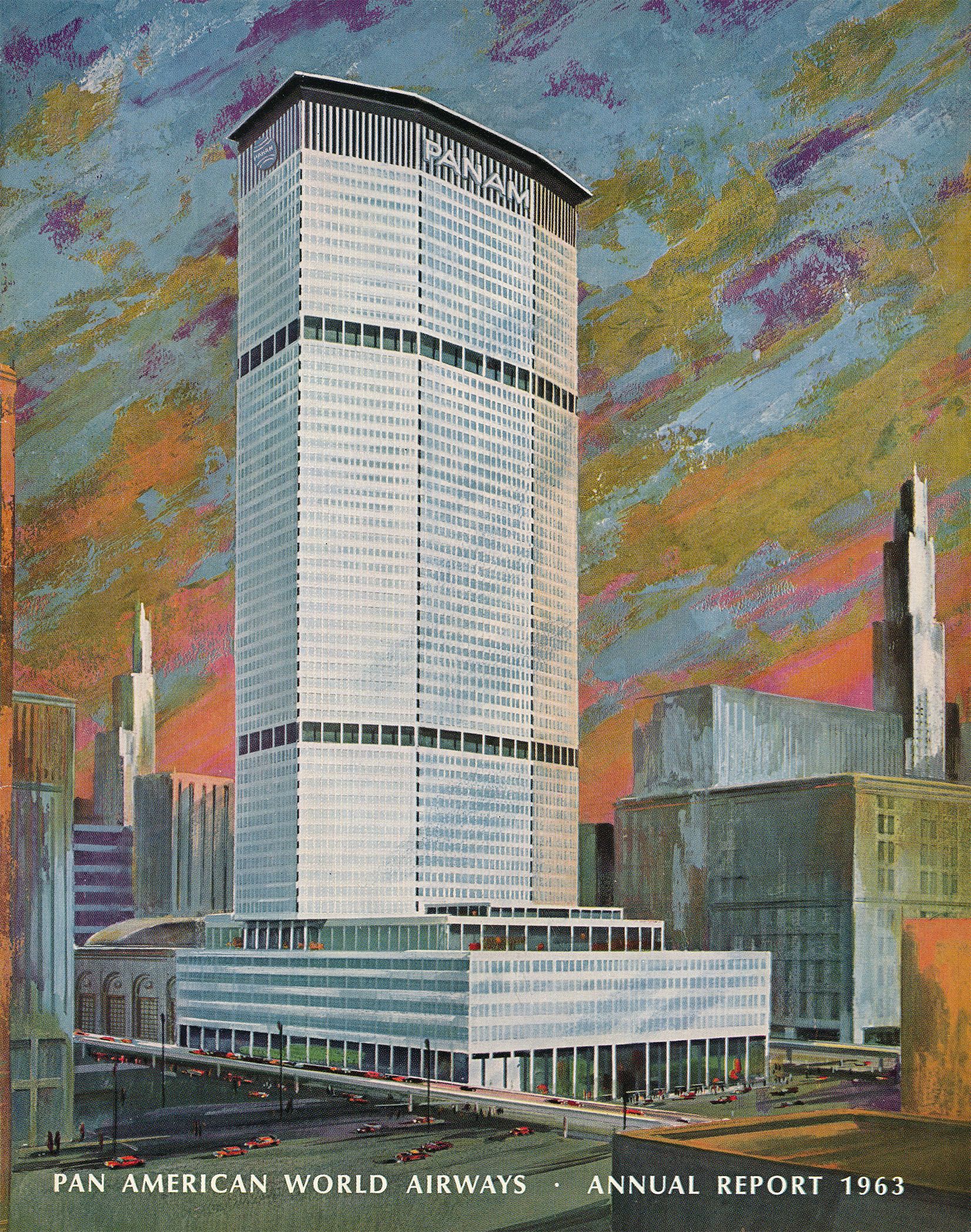A REALITY AT LAST
The Pan Am Building and the beginnings of a legacy
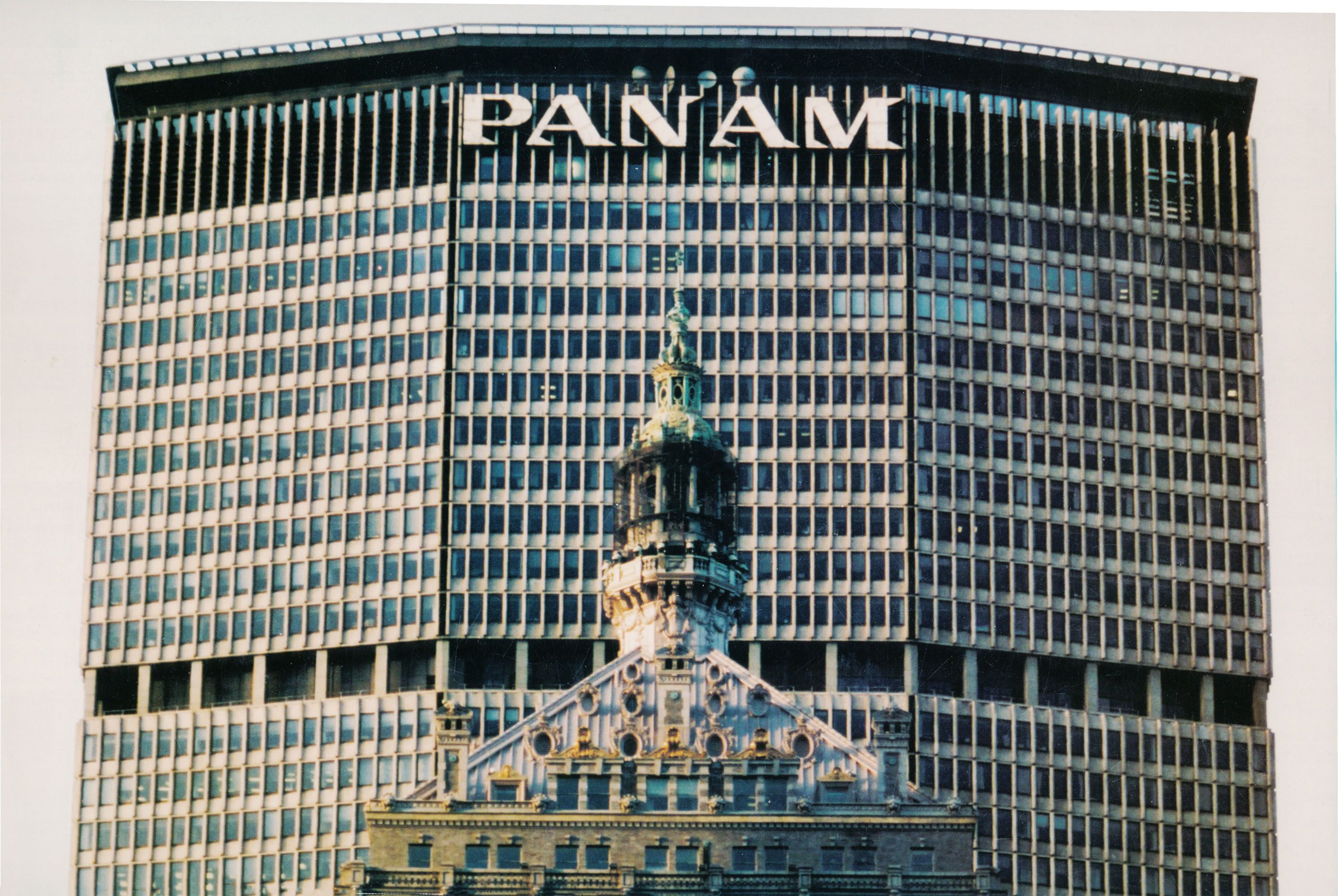
"OPENING DAY… Dignitaries assembled for ribbon cutting which opened Pan Am Building are, left to right: Jack Cotton, chairman of City Centre Properties, co-owners of building; Mrs. Erwin S. Wolfson, widow of the building’s originator and builder; Governor Nelson A. Rockefeller of New York State; Mayor Robert F. Wagner of New York City; and Pan American President Juan T. Trippe."
"OPENING DAY… Dignitaries assembled for ribbon cutting which opened Pan Am Building are, left to right: Jack Cotton, chairman of City Centre Properties, co-owners of building; Mrs. Erwin S. Wolfson, widow of the building’s originator and builder; Governor Nelson A. Rockefeller of New York State; Mayor Robert F. Wagner of New York City; and Pan American President Juan T. Trippe."
Documentary footage by the U. S. Department of Commerce on the construction and opening of the Pan Am Building at 200 Park Avenue, New York City , c. 1963. (PAHF Collection).
THE PAN AM BUILDING IS BORN
A MESSAGE FROM THE PRESIDENT OF PAN AMERICAN AIRWAYS, ON THE DEDICATION OF THE PAN AM BUILDING
"All great buildings are monuments as well as shelters. They have a purpose beyond their use. The enormous pyramids of Egypt were erected not only to preserve the bodies of the Pharaohs from desecration and the common dust, but to remind posterity of their magnificence and power. We build for other ends. Our noblest structures are created not to preserve the dead, but to serve the living, and the monumental purpose is not to commemorate great kings but to speak for the imagination, the vitality, and the strength of a free people.
The building we dedicate today is such a structure. It will be a working place for thousands of men and women. It will be a monument to our civilization and to our free-enterprise system. Its size is impressive. It is the largest office building in the world. Its beauty is evident. Its admirable proportions and pure mass dominate a crossing of famous streets in a famous city — and mark a harmonizing center toward which men’s eyes will turn with recognition and delight for years to come.
Back of its great size and balanced beauty there are factors of human effort and cooperation which add a new dimension. It was conceived and constructed by an Atlantic partnership, whose continuing vitality is evident by the presence here today of the President of the Board of Trade of Great Britain, and the Secretary of Commerce of the United States. Through this partnership the savings of hundreds of thousands of private citizens on both sides of the Atlantic have been channeled to finance the work and bring this joint effort to success.
All this is history now, but there is something more which is not history — Pan American. The Company for which I speak today, was named some 35 years ago to develop human understanding and unity in a diverse and separated hemisphere. That name has gradually changed on the tongues of the millions of human beings who have spoken it, not in this hemisphere alone, but all over the world. Use has worn it away to two short syllables — PAN AM— but these short syllables now speak for human unity throughout the whole free world — a unity furthered by fast, frequent, low-cost transportation that has made for us many close neighbors and true friends on every continent.
On behalf of 30,000 Pan Am men and women, at their posts along the air routes of the world, and on behalf of our 40,000 shareholders it is my privilege to name the great building, which will serve as the Home Office of our Company, the Pan Am Building." – Juan T. Trippe.
OPENING Ceremonies
Cover of the Pan American World Airways Menu for the March 7, 1963 Reception.
Cover of the Pan American World Airways Menu for the March 7, 1963 Reception.
Pan Am Reception Menu selections at the March 7, 1963 Opening.
Pan Am Reception Menu selections at the March 7, 1963 Opening.
The Pan Am Building was officially opened with a high-profile ribbon cutting on March 7, 1963.
Along with an audience of hundreds, the big event was attended by New York’s government luminaries, the US Commerce Secretary, Jack Cotton and of course Juan Trippe.
But Erwin Wolfson was not there. After a cancer diagnosis, he had continued to oversee the progress of the new building, making aerial survey trips over the site by helicopter from his home, until his death only a few months later in June 1962. In his honor, a large bust of Wolfson by was installed in the lobby, unveiled by his wife, Rose, at the opening.
Pan Am Building and Grand Central Terminal by Pan Am photographer Paul Friend.
Pan Am Building and Grand Central Terminal by Pan Am photographer Paul Friend.
With the building open for business, it quickly assumed its place in the city’s fabric.
A month after the opening, it was expected that the final tenant would be in place within five months. Of the 7,500 workers who participated in the construction, only a few were still on the job.
More developments followed in the coming months. Among the most notable was the news in July that Pan Am had agreed to buy two Boeing-Vertol 107 twin-rotor helicopters. They would be leased to New York Airways to add to their fleet in anticipation of opening the proposed rooftop heliport service. That wouldn’t actually happen until December 1965, but the news added an exciting aura to the environment at 200 Park Avenue.
And Panamac was not the only large computer system in the building. The second largest tenant, the Commercial Union Insurance Group, had also installed a large data processing system, taking advantage of the robust telecommunications infrastructure that was available from the start.
On the first floor, Rochette and Parzini, masters of plaster sculpture, were creating a unique stylized elliptical bas-relief representation of Pan Am’s iconic globe in the new ticket office and information center.
Pan Am Building (PAHF Collection from University of Miami Special Collections).
Pan Am Building (PAHF Collection from University of Miami Special Collections).
Source: Library of Congress, New York World-Telegram and Sun Newspaper Photograph Collection. Pan Am Building, New York City, aerial view: "Photograph shows an aerial view of midtown Manhattan, including the Chrysler Building and the Pan Am Building, later known as the MetLife Building." 1964, by Herman Hiller photographer.
Source: Library of Congress, New York World-Telegram and Sun Newspaper Photograph Collection. Pan Am Building, New York City, aerial view: "Photograph shows an aerial view of midtown Manhattan, including the Chrysler Building and the Pan Am Building, later known as the MetLife Building." 1964, by Herman Hiller photographer.
Source: Library of Congress, U.S. News & World Report Magazine Photograph Collection. Pan Am Building New York City, 1974 by Thomas O’Halloran.
Source: Library of Congress, U.S. News & World Report Magazine Photograph Collection. Pan Am Building New York City, 1974 by Thomas O’Halloran.
THE PAN AM BULDING SURPRISED SKEPTICS WHO DOUBTED IT WOULD ATTRACT TENANTS QUICKLY, BUT ONE MONTH AFTER THE BUILDING OPENED, ONLY 7% OF RENTABLE SPACE REMAINED UNOCCUPIED.
The Pan Am Building was notable in so many ways, not all of which were obvious. For example, the 65 elevators and 18 escalators constituted the largest single internal transport system ever put into a building. The $70 million mortgage (held by the New York State Employees Pension System) was the largest ever taken out on any New York property. The HVAC system was the largest ever installed in a skyscraper. The annual exterior cleaning contract cost a record $1.3 million. It was said the building’s $50,000 appraisal fee was the largest ever paid for any structure.
The Pan Am Building decidedly changed the prospect looking north or south of the building from along Park Avenue. Whether observers liked it, hated it, or accepted its presence without judgment, midtown Manhattan was not going to look or feel the same going forward.
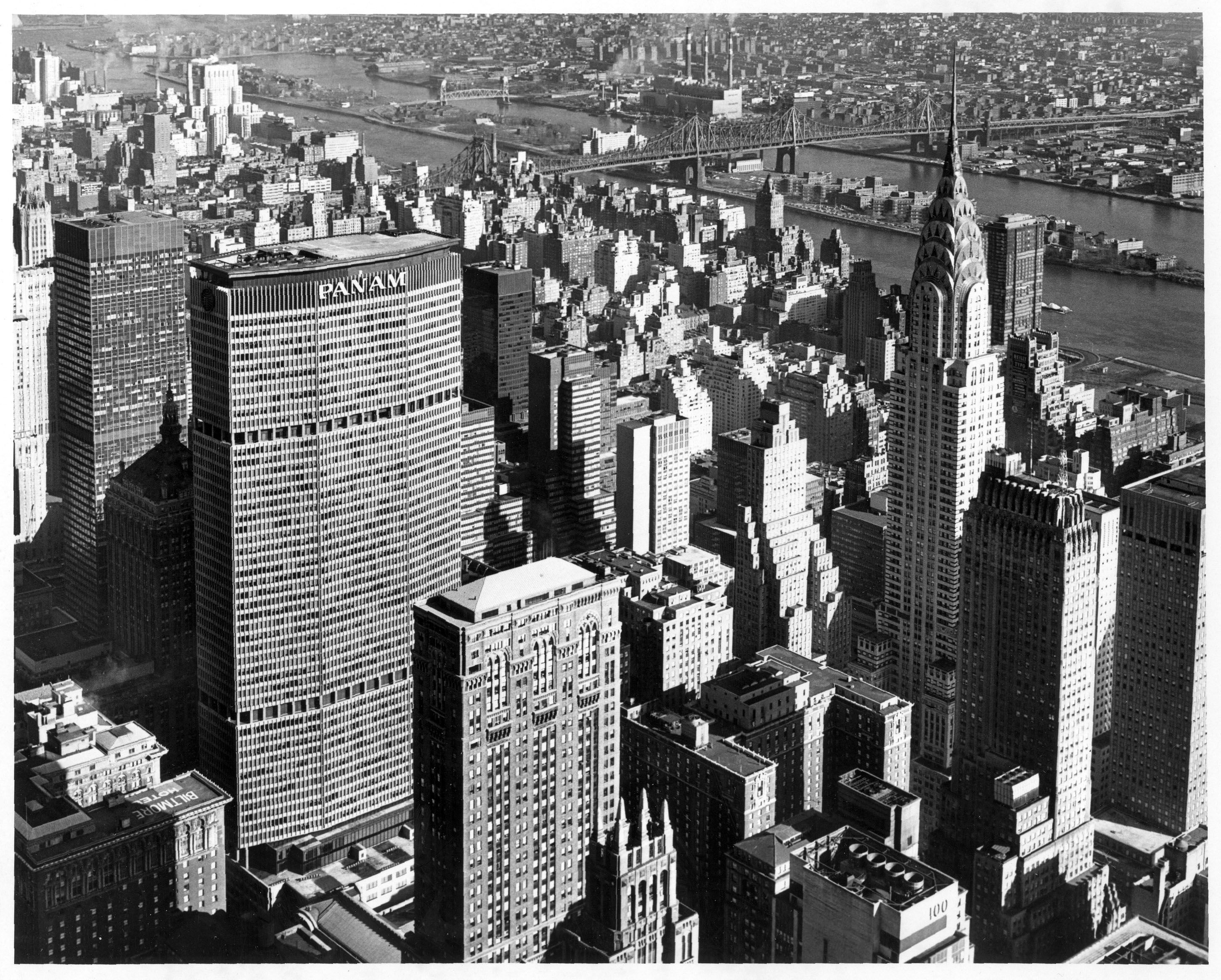
Helicopter Service Begins
New York Airways Boeing Vertol BV-107 at the Pan Am heliport, showing the top of the Empire State Building in the background (PAHF Collection).
New York Airways Boeing Vertol BV-107 at the Pan Am heliport, showing the top of the Empire State Building in the background (PAHF Collection).
The idea of aerial transport right to the tops of skyscrapers went back decades. But until the Pan Am Building included a working heliport at the top, no one had put the idea into practice.
New York Airways (NYA) would provide the service. The helicopter airline that had been operating successfully since1953, and by 1963, had a small fleet of 25-passenger twin-rotor Boeing Vertol 107 helicopters. Pan Am had leased the heliport, and was ready to begin service to JFK Airport. To get the skyscraper service on its feet, Pan Am provided a subsidy to NYA, and purchased two BV-107s to lease back to the helicopter airline.
Before service could begin, there was considerable bureaucratic process to navigate. Both the Federal Civil Aeronautics Board (CAB) and three New York City agencies had oversight. The city permits were particularly problematic given the strong opposition from neighboring building owners and some local civic groups, who cited noise and safety concerns. Months went by but finally, after often contentious hearings and “get acquainted” flights by city officials, the service got the green light.
New York Airways helicopter taking off at the Pan Am Building over Grand Central Terminal, northwest view (PAHF Collection).
New York Airways helicopter taking off at the Pan Am Building over Grand Central Terminal, northwest view (PAHF Collection).
"NEW YORK – At 6:42 Tuesday night with the Christmas lights of the Chrysler Building so close they could almost be touched, a twin-turbine helicopter roared off a pad atop the Pan Am Building 800 feet above the city streets and flailed the night air in a sweeping turn around the RCA Building..."
On December 21, 1965, following a celebratory event at the nearby Waldorf-Astoria, a brief opening ceremony took place at the $800,000 rooftop facility.
From his home in Minnesota Vice-President Hubert Humphrey gave the signal by telephone to turn on the heliport lights. In his remarks he added: “I hope other cities will soon follow New York’s example.”
Then there was a quick ribbon cutting by New York Governor Rockefeller, Mayor Wagner, and Pan Am’s Chairman Juan Trippe. The initial flight carried 18 passengers, including New York’s Cardinal Spellman, who was on his way to a Pan Am flight to Vietnam for a Christmas visit to American troops. At 6:11 pm, the New York Airways’ flight was off for the 7-minute trip to JFK Airport.
View from a New York Airways helicopter flying between the roof of the Pan-Am building in downtown New York City to JFK airport, 1967, by John Atherton (Wikimedia Commons, CC-2).
View from a New York Airways helicopter flying between the roof of the Pan-Am building in downtown New York City to JFK airport, 1967, by John Atherton (Wikimedia Commons, CC-2).
1965 Brochure: "NOW Whirlybirds fly from the Pan Am Building direct to Pan Am Jets" featuring New York Airways helicopter service (University of Miami Special Collections, Pan American World Airways, Inc records).
1965 Brochure: "NOW Whirlybirds fly from the Pan Am Building direct to Pan Am Jets" featuring New York Airways helicopter service (University of Miami Special Collections, Pan American World Airways, Inc records).
The next morning, regular service began, with 18 outbound flights, and 17 arrivals.
Fare to JFK was $7.00. Pan Am was eager to publicize and support the new service. Passengers could check-in for a Pan Am flight 45 minutes before a JFK departure directly at the base of the building, and be whisked up to the heliport by some of the world’s fastest elevators. It would take at least that long just to get to the airport by taxi.
"The helicopter first flew westward over neon-lit Times Square and streets filled with toy-sized automobiles and dotted with red, green, yellow and other lights. It swung northward over the Hudson River where huge ocean liners sat with lights gleaming along superstructures and then wheeled back across Manhattan Island past the glass-sided United Nations building on the East River and across Queens with its apartments and factories to Kennedy."
After an initial burst of service during a citywide transit strike, the routine soon settled in with about 700 passengers a day using the service to and from both JFK and Teterboro Airport in New Jersey. Pan Am was providing NYA with about $2million annually in subsidies, and when the agreement between them came up for renewal in early 1968, the two sides failed to come to terms. So on February 15th 1968 the service was terminated. Despite suggestions that it would start up again, the heliport would lay dormant for years.
"THE HELICOPTER"
Click on Closed Captions for Translation by Juergen Fraenznick
"The Helicopter" (c. 1966) is the German language version of Sidney Styber's short film about New York Airways' Boeing-Vertol 107 helicopter service from the Pan Am Building to JFK Airport. The film's narrative contrasts a tedious and frustrating taxi ride versus the exciting and spectacular short trip via air from the top of the Pan Am Building. The colorful film includes some excellent air-to-air shots of the chopper in flight, the Pan Am WorldPort/UTB building and ground operations at JFK Airport, and NY Airways personnel at work. Digitized from the original 16mm print.
Transcript
"The Helicopter," Pan American World Airways, 1966, German Language version. translated into english by Juergen Fraenznick.
This Boeing helicopter can seat up to 25 passengers. He took off from the PanAm Heliport in Manhattan. In a few minutes he will land at John F. Kennedy International Airport, 21 kilometers away.
Travelers have embraced the helicopter as the best mode of transport to get to the airport.
Traveling to the airport or to the city is now easy. You land on the PanAm building in the heart of New York.
Departure formalities are completed at the counter on the ground floor. You no longer need to worry about your luggage until you arrive at your destination.
"Taxi! – Taxi!!" There are of course other ways to get to the airport, but they are not always as pleasant nor are they quite as interesting.
In less than a minute you can reach the heliport on the roof.
You can also take a cab from Manhattan, but it will take you five times as long to get to Kennedy Airport.
As the taxi moves into the perfectly normal maze of traffic, the New York Airways helicopter flies overhead.
Kennedy International Airport.
Free bus transportation of passengers to all connecting flights.
A flight to the city. It's just as easy to fly into New York. Almost 50 flights operate daily in both directions. Baggage is transported on the same flight.
Some passengers fly by helicopter just to enjoy the unique great view of New York.
This jet age, with ever-increasing air speeds and slowing road traffic, in which airports are being moved further away from city centers, has discovered the helicopter as a civilian means of transport. A logical consequence of this age.
A Short-lived renaissance
No one anticipated the next helicopter arrival.
On May 23rd 1974, 21-year-old David Kamaiko hijacked an executive Bell Jet Ranger II helicopter during refueling at the 34th Street East Side heliport. He forced young ramp agent William Hale into the copter at gunpoint and ordered pilot Thomas Olivo to take off. After some confused dialog aboard the chopper about where to fly next, Kamaiko decided the Pan Am Building would do. Alerted by Olivo, authorities were ready when the chopper touched down. At that point, Kamaiko shot Olivo in the arm, and Hale tackled the hijacker, successfully disarming and subduing him. Kamaiko was soon being led away to a quick arraignment for air piracy.
“Pan Am Building Heliport," New York Airways Annual Report, 1964, p. 5 (Internet Archive, Columbia University Libraries). Photo:
“Pan Am Building Heliport," New York Airways Annual Report, 1964, p. 5 (Internet Archive, Columbia University Libraries). Photo:
It would be almost three years before another helicopter would land on the roof of the Pan Am building.
After more debate, and tests, the City gave its approval to restart the service. In early February 1977, New York Airways, now operating single-rotor Sikorsky S-61s, once again picked up where they had left off. The Sikorskys would be less noisy then the twin-rotored BV-107s used in the past. Now the heliport would service all three major New York airports. The fare to JFK had risen to $23.15. Pan Am was once again promoting the service, which now served a greatly expanded terminal at JFK known as the “Worldport.”
But the renaissance was short-lived. On May 16th, tragedy struck. A right landing gear strut on an S-61 gave way during passenger boarding and the big helicopter keeled over with its rotor spinning. The whirling blades fatally cut down four passengers waiting to board, and sheared off on the helipad surface. Metal shards and glass showered off the high building, carried as far away as Madison Avenue, a block to the west, where a young woman was fatally struck, and several others were seriously injured. A piece of rotor blade wafted down and lodged in a 39th story window, where moments before a worker had stepped out of the office.
It was a tragedy, and although New York Airways suggested a resumption of service was possible, even imminent, the sun had set on skyscraper helicopter service in New York City. New York Airways was out of business two years later.
Passengers board a helicopter on the Pan Am Building roof (PAHF Collection).
Passengers board a helicopter on the Pan Am Building roof (PAHF Collection).
Helicopter advertised in February 1-28, 1966 Pan Am Timetable, p. 2 (University of Miami Special Collections, Pan American World Airways, Inc. records). https://digitalcollections.library.miami.edu/digital/collection/asm0341/id/27137
Helicopter advertised in February 1-28, 1966 Pan Am Timetable, p. 2 (University of Miami Special Collections, Pan American World Airways, Inc. records). https://digitalcollections.library.miami.edu/digital/collection/asm0341/id/27137
New York Airways helicopter aloft (PAHF Collection).
New York Airways helicopter aloft (PAHF Collection).
Pan Am Building Gallery
New York, Manhattan, view of Chrysler and Pan Am Buildings by Harold Mayer, Dec. 1975 (Courtesy, University of Wisconsin-Milwaukee Libraries).
New York, Manhattan, view of Chrysler and Pan Am Buildings by Harold Mayer, Dec. 1975 (Courtesy, University of Wisconsin-Milwaukee Libraries).
Pan Am Building postcard (Morton1905 Creative Commons, Flickr) https://www.flickr.com/photos/morton1905/14240932729/
Pan Am Building postcard (Morton1905 Creative Commons, Flickr) https://www.flickr.com/photos/morton1905/14240932729/
The Pan Am Building looking south on Park Avenue (PAHF Collection).
The Pan Am Building looking south on Park Avenue (PAHF Collection).
View of Pan Am Building from Park Avenue South (PAHF Collection, scanned by John Luetich).
View of Pan Am Building from Park Avenue South (PAHF Collection, scanned by John Luetich).
The Pan Am Building and Grand Central Terminal aerial view (PAHF Collection).
The Pan Am Building and Grand Central Terminal aerial view (PAHF Collection).
"The Pan Am Building, seen from Park Avenue in 1980.. Grand Central Terminal is in front of it. The Pan Am Building is one of the most recognizable structures in New York. It was opened in 1963. It has 59 floors above ground, and is 808 ft (345 m) high. It is now called the MetLife Building" (Roger Wollstadt, Flicker Creative Commons). https://creativecommons.org/licenses/by-sa/2.0/
"The Pan Am Building, seen from Park Avenue in 1980.. Grand Central Terminal is in front of it. The Pan Am Building is one of the most recognizable structures in New York. It was opened in 1963. It has 59 floors above ground, and is 808 ft (345 m) high. It is now called the MetLife Building" (Roger Wollstadt, Flicker Creative Commons). https://creativecommons.org/licenses/by-sa/2.0/
Pan Am Building from the northeast, showing Chrysler and Helmsley buildings (PAHF Collection).
Pan Am Building from the northeast, showing Chrysler and Helmsley buildings (PAHF Collection).
the legacy of the pan am building
In March, 1977, as the helicopter service was entering its final phase, other events were unfolding that would lead to finalization of a different dimension of the Pan Am Building’s story – the matter of the building’s ownership.
Back in 1960, when Pan Am signed the deal for the 25-year lease, the company also took a 10% equity stake as well. Erwin Wolfson and his British partner Jack Cotton held the balance equally between them. But by 1968, both men had died. Pan Am moved to obtain a controlling interest in Grand Central Building, Inc., the corporation created to own and manage the building. Jack Cotton’s estate sold its 45% share to the airline that year, giving Pan Am a controlling interest. In May, Juan Trippe stepped aside as Chairman, after a 41-year career at Pan Am. He was leaving the company with a solid position, including its control of the Pan Am Building.
But management of the building had not gone smoothly in the ensuing years. By 1977, a lawsuit brought by the trustees of the estate of Erwin Wolfson claimed that Pan Am had been working to engineer their forced sale of the 45% they still retained by withholding dividend payments, and illegally subleasing space.
It proved a losing battle. Just over a year later, the Wolfson Estate sold its stake in the building. Now Pan Am, after18 years, had full ownership of the Pan Am Building. Not long after that, early in 1979, Pan Am paid Penn Central Properties (the successor to the once-mighty New York Central Railroad) $25 million for the property on which the building sat. The sale ended another lawsuit.
But the future for Pan American’s now total control of the building was going to be short-lived. Even as the ink was drying on the land deal, William Seawell, Pan Am’s Chairman, was considering how to face immediate problems. The possibility of moving the airline’s headquarters to the suburbs was a matter of public discussion.
By the following year, arrangements were being made to auction the building. After a first round, the group of bidders had been winnowed down to five, Met Life among them (as was Donald Trump). The insurance company won the bid for $400 million – the most expensive building sale price up to that time. The net proceeds boosted the airline’s quarterly profit, but it did not alter long-term prospects for Pan Am.
But the now iconic presence above Park Avenue was a reminder of what had been. Pan Am was a tenant, where once it had been the landlord. The big letters were still there, lighted up at night as they had been since 1963. Met Life already had an older building downtown which was commonly known as the Met Life Building, and more years rolled by, until Pan Am’s final chapter closed at the end of 1991. Not long after, in early 1992, Met Life decided it was time to change out the big letters and the trademark globes that had for so long identified the building at 200 Park Avenue. The Pan Am Building would now be –visually at least – the Met Life Building.
Sign removal from Pan Am Building, 1992. Slide 1 (PAHF Collection).
Sign removal from Pan Am Building, 1992. Slide 1 (PAHF Collection).
Sign removal from Pan Am Building, 1992. Slide 2 (PAHF Collection).
Sign removal from Pan Am Building, 1992. Slide 2 (PAHF Collection).
Sign removal from Pan Am Building, 1992. Slide 3 (PAHF Collection).
Sign removal from Pan Am Building, 1992. Slide 3 (PAHF Collection).
Sign removal from Pan Am Building, 1992. Slide 4 (PAHF Collection).
Sign removal from Pan Am Building, 1992. Slide 4 (PAHF Collection).
Southeast view of the Pan Am Building with the Chrysler Building nearby (PAHF Collection, scanned by John Luetich).
Southeast view of the Pan Am Building with the Chrysler Building nearby (PAHF Collection, scanned by John Luetich).
Of course the building remains as ever – monumental and imposing – just as Walter Gropius, Pietro Belluschi, and Richard Roth had meant it to be.
Recent aerial photo by Michelle Young, Untapped Cities, New York (Wikimedia Commons). Photo:
Recent aerial photo by Michelle Young, Untapped Cities, New York (Wikimedia Commons). Photo:
It continues fulfilling an important role in the life of Manhattan, as Erwin Wolfson had planned for it. For that matter, it justifies the vision that William Wilgus had for Grand Central over a century ago.
Pan Am Building in New York City, taken January 16, 1987 by Gordon Bevan (Wikimedia Commons). Photo:
Pan Am Building in New York City, taken January 16, 1987 by Gordon Bevan (Wikimedia Commons). Photo:
And as Juan Trippe understood, its presence will continue to validate the importance of Pan American World Airways – even if the big letters at the top have changed. the airline itself has become part of aviation's, and America's, legacy.
Pan Am Building concept on the cover of the Pan American World Airways 1963 Annual Report (PAHF Collection).
Pan Am Building concept on the cover of the Pan American World Airways 1963 Annual Report (PAHF Collection).
